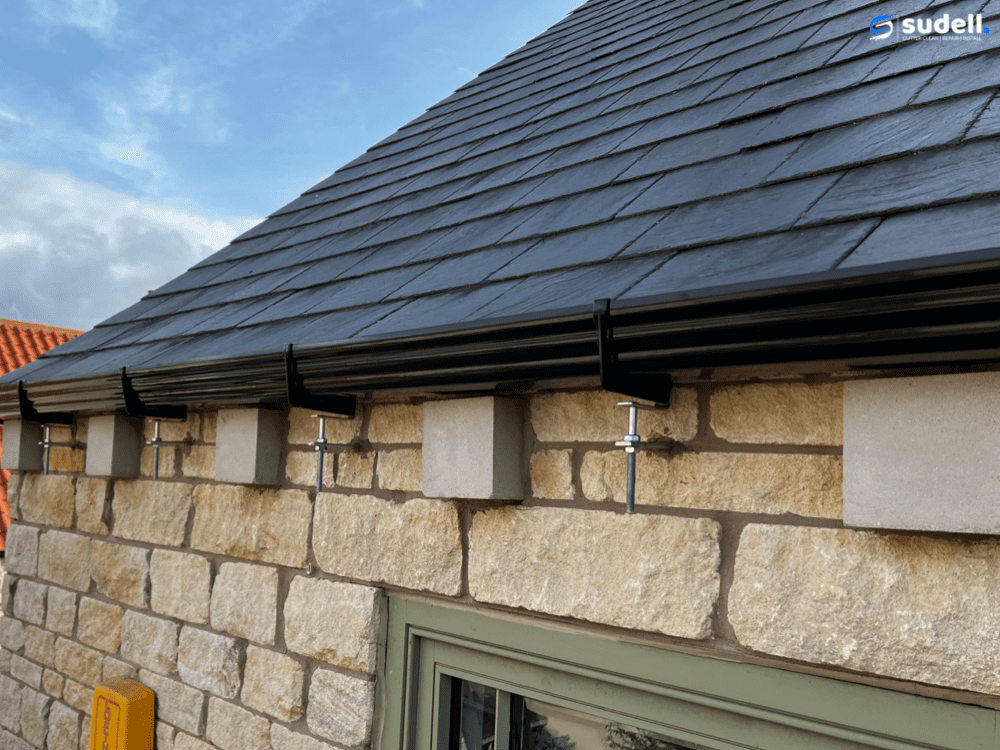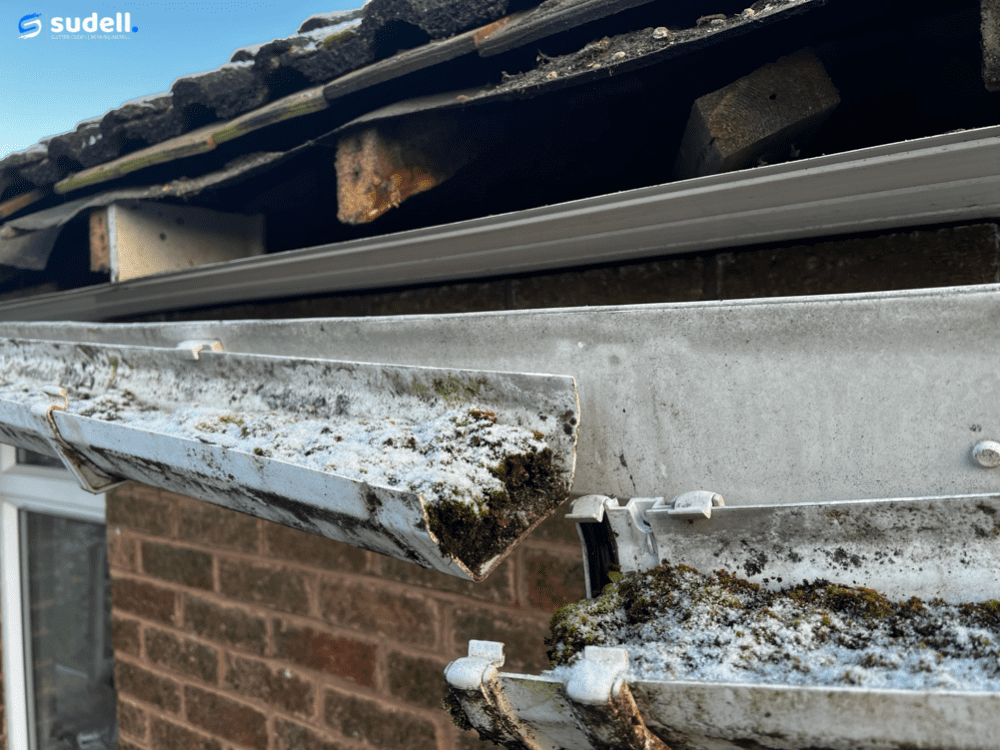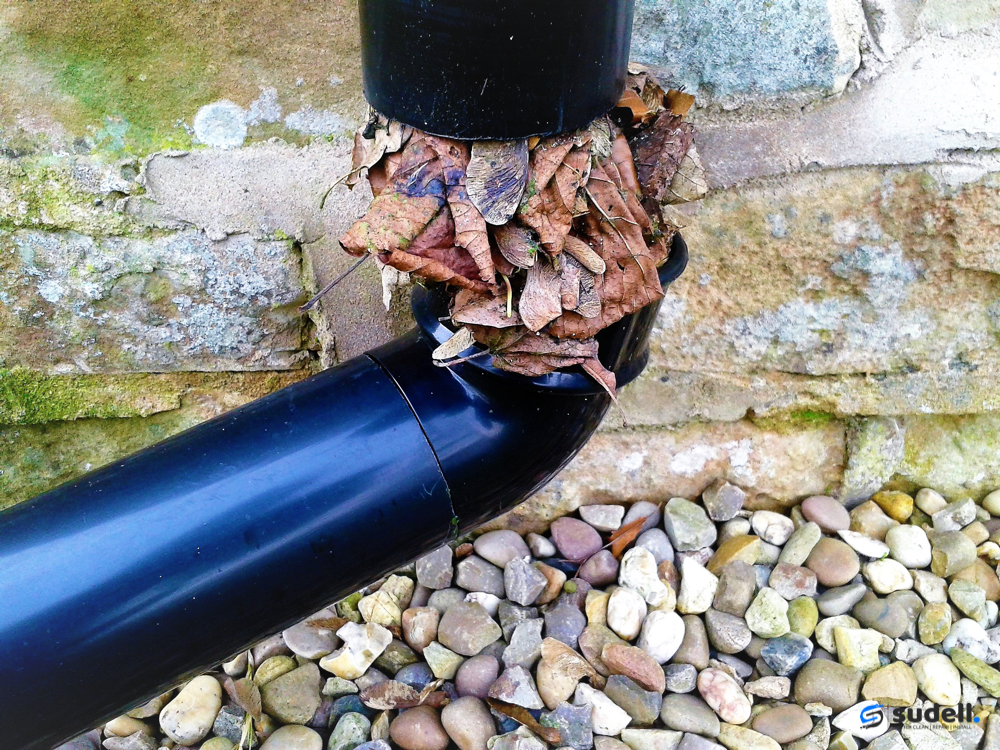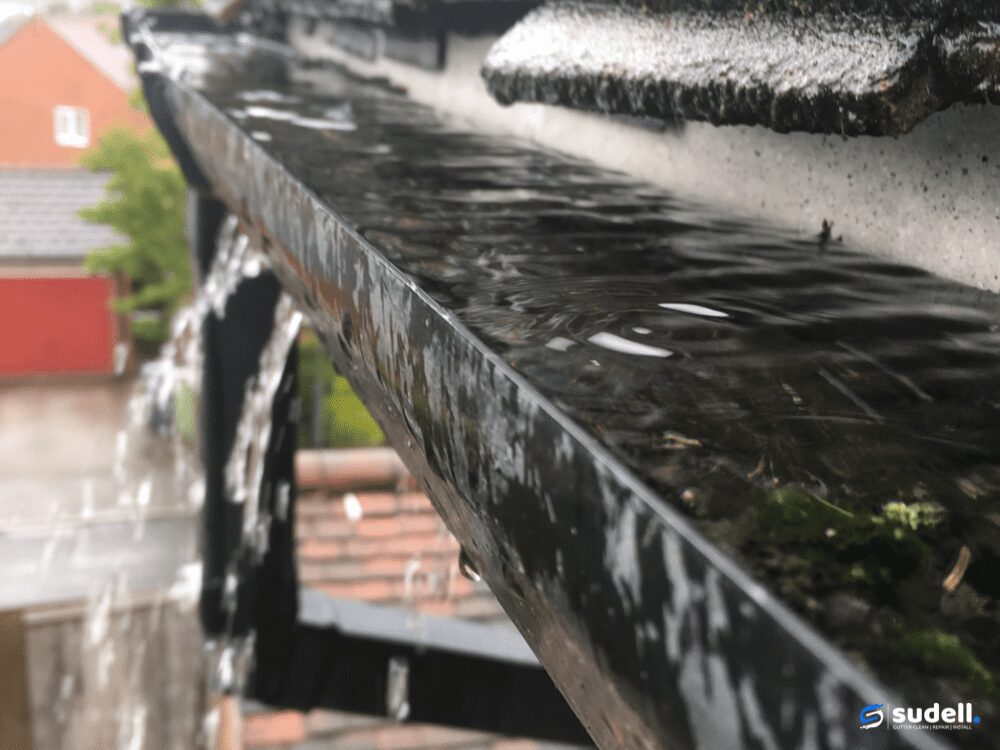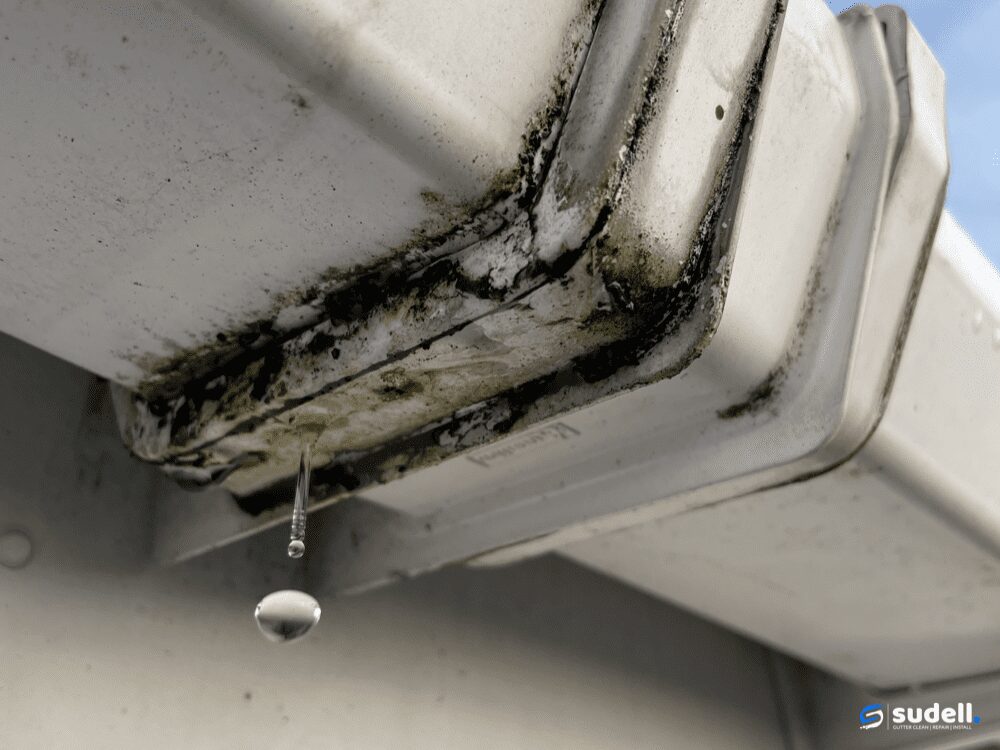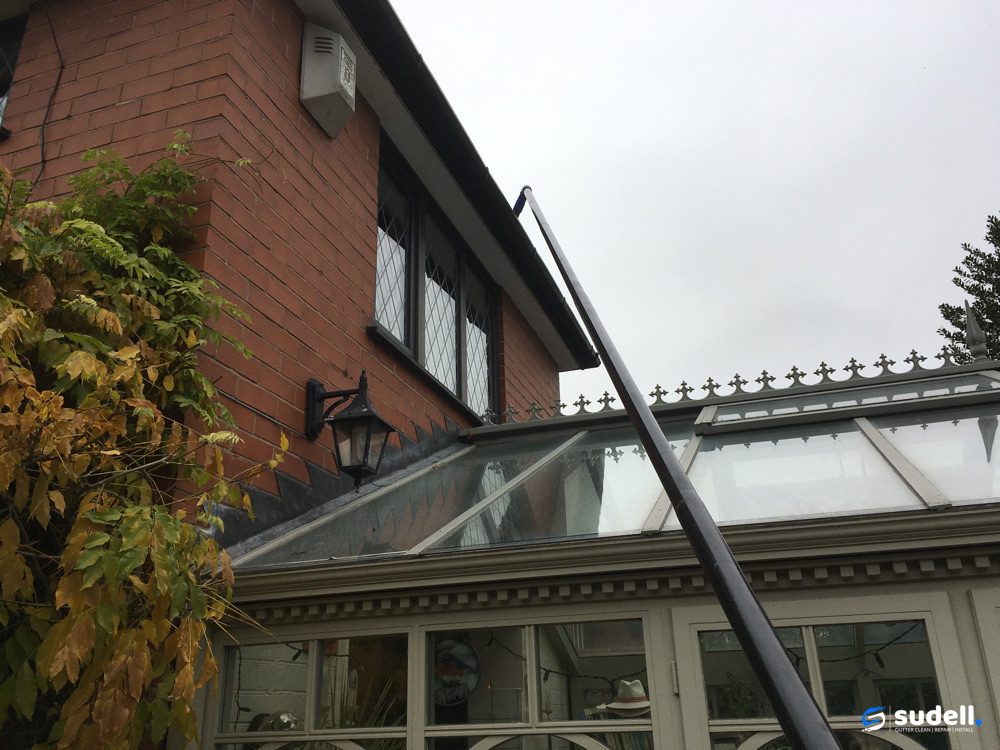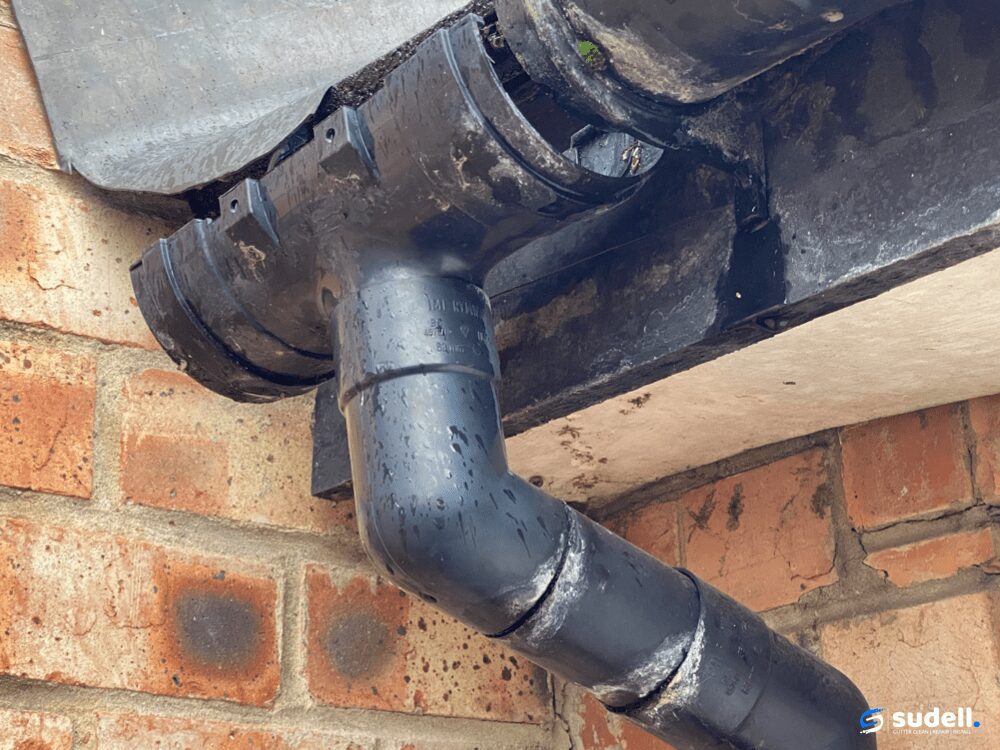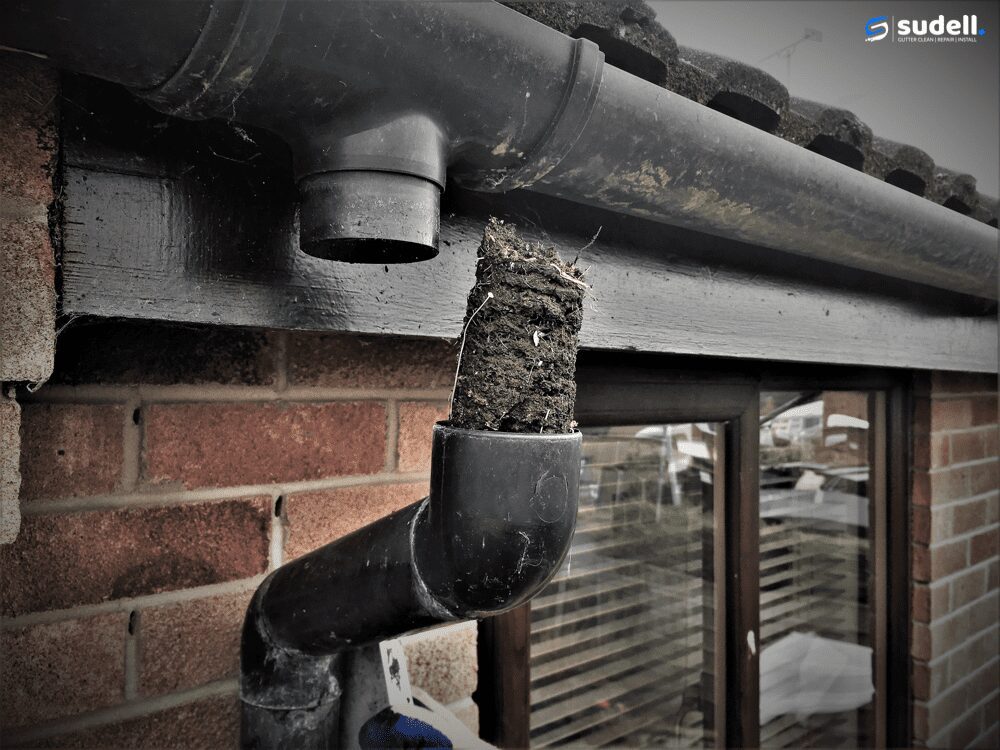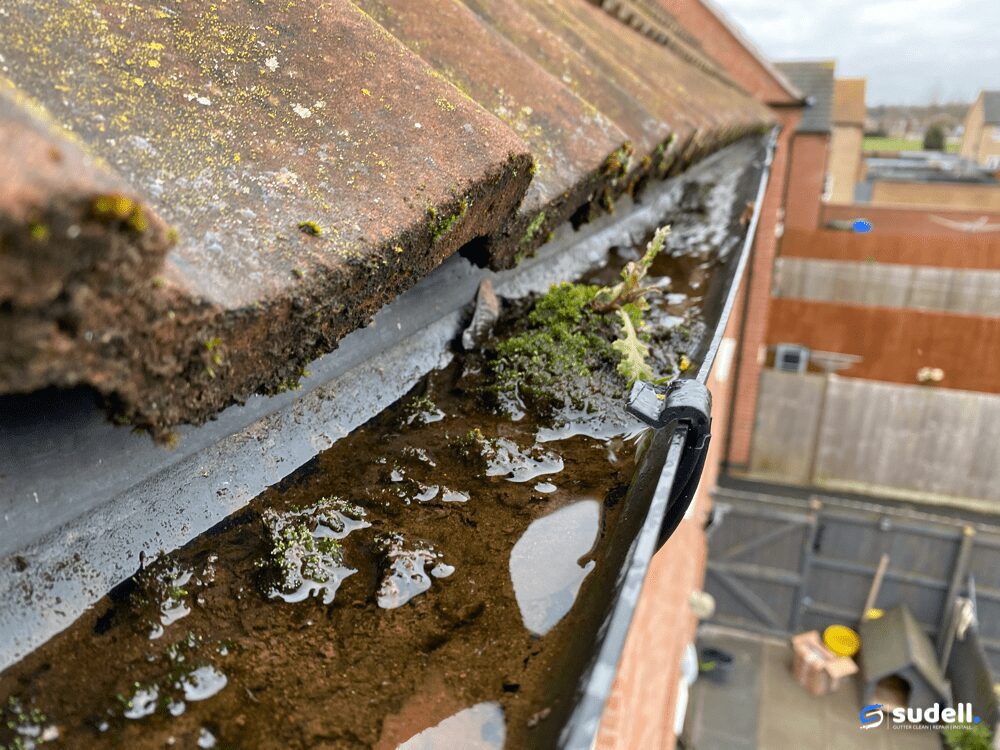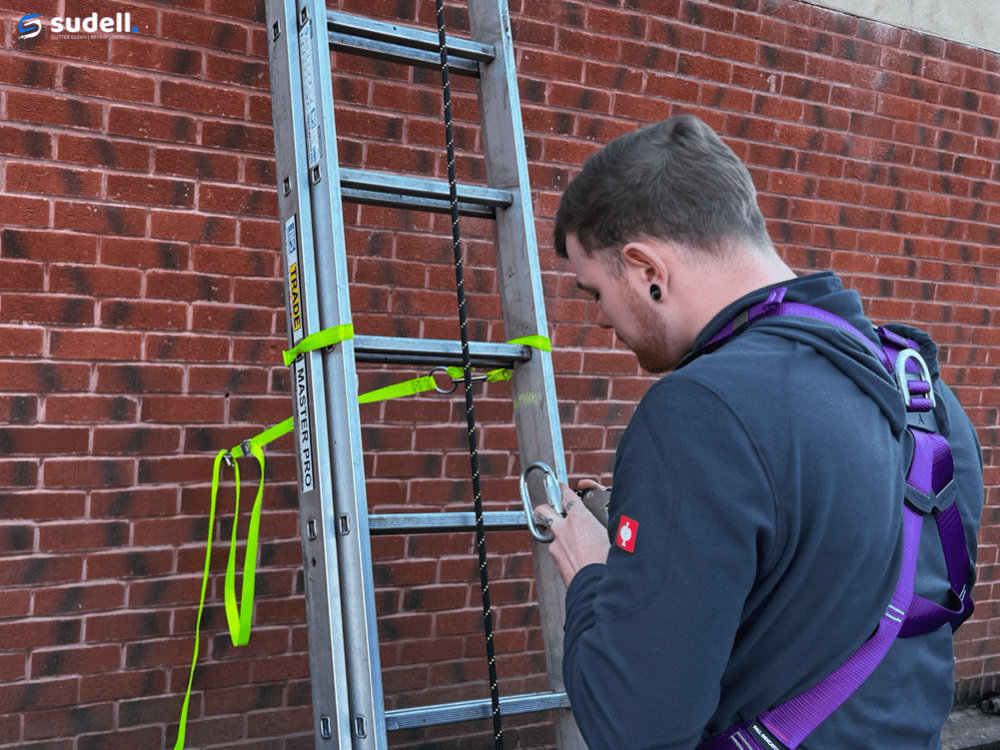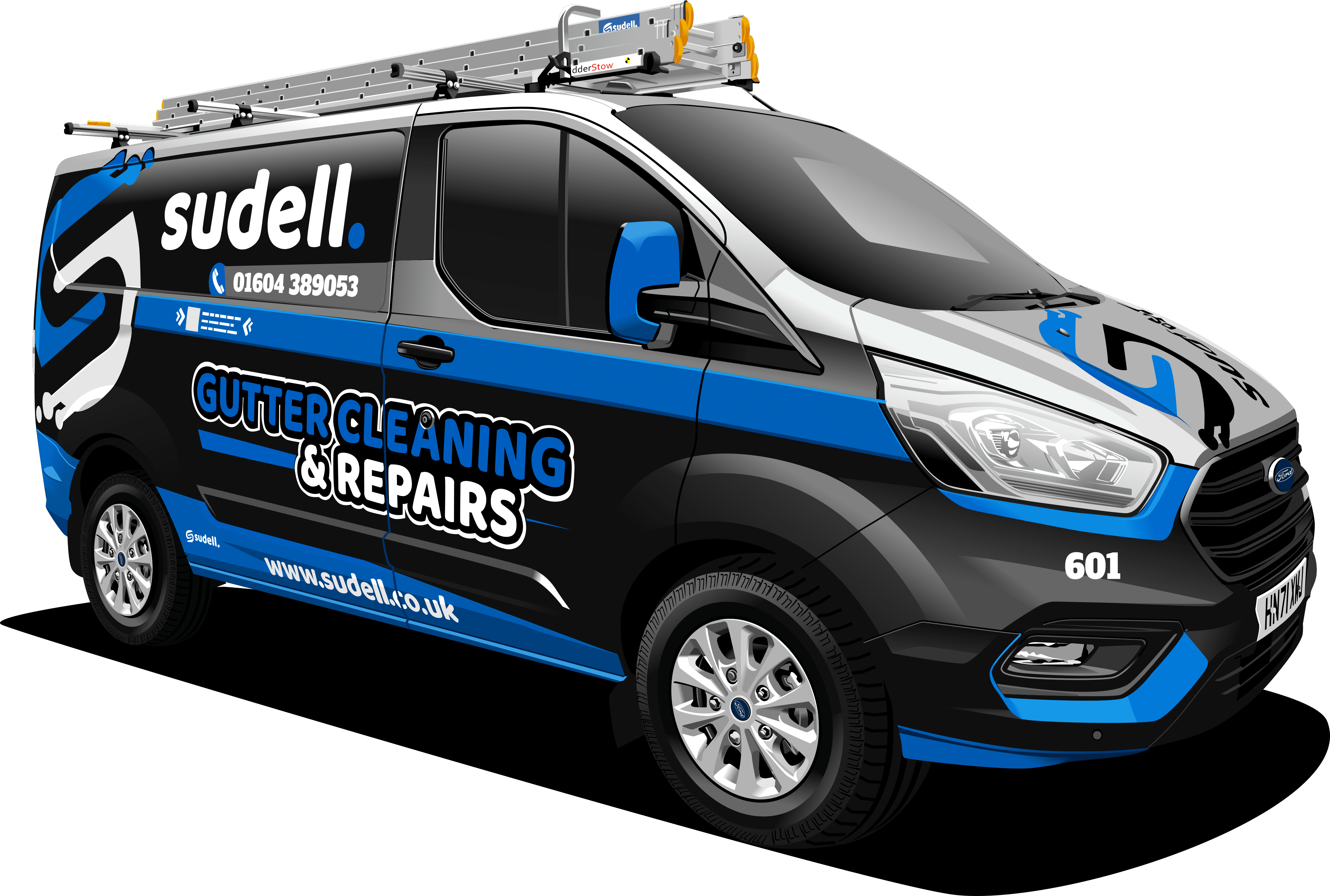Professional Gutter Services
Welcome to Sudell Gutter Cleaning your local gutter cleaning and repair service. We are a hugely popular gutter maintenance company, known for our extremely high standard of work at surprisingly low prices, that beat many of our competitors. We are highly trained and fully equipped, and take pride in what we do. Due to high demand we continue to extend our Award Winning gutter services across the United Kingdom. Furthermore, our franchise teams are local, independently owned and operated.
How Can We Help You?
Our Range of Gutter Services
Gutter Cleaning

Gutter Cleaning using the best, most powerful gutter cleaning equipment available. Guaranteed results that no other gutter cleaning machine can keep up with. Lightweight carbon fibre poles allow us to clean gutters up-to 4 stories high, difficult gutters over conservatories.
Free Gutter Inspection
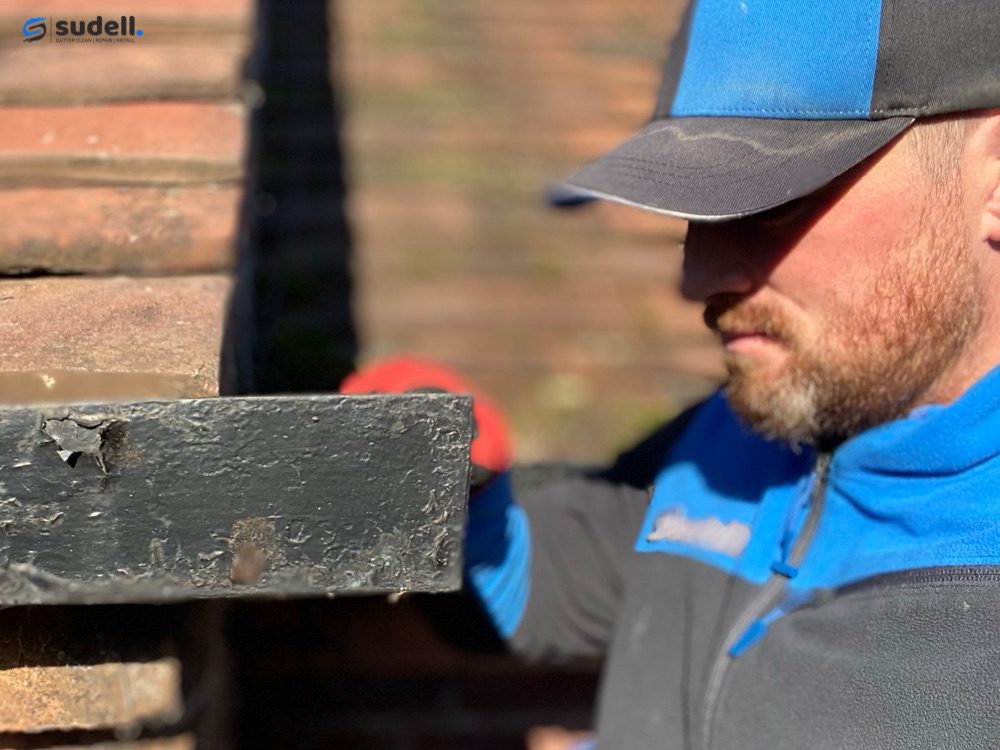
Get your roof and gutters checked by an expert with a FREE roof and gutter inspection by Sudell Gutter Cleaning. This popular gutter service ensures a thorough check of your roof and gutters which can help you identify any potential problems, and we can advise you how to put them right. Perfect for new and existing homeowners, landlords and commercial customers.
Gutter Repairs
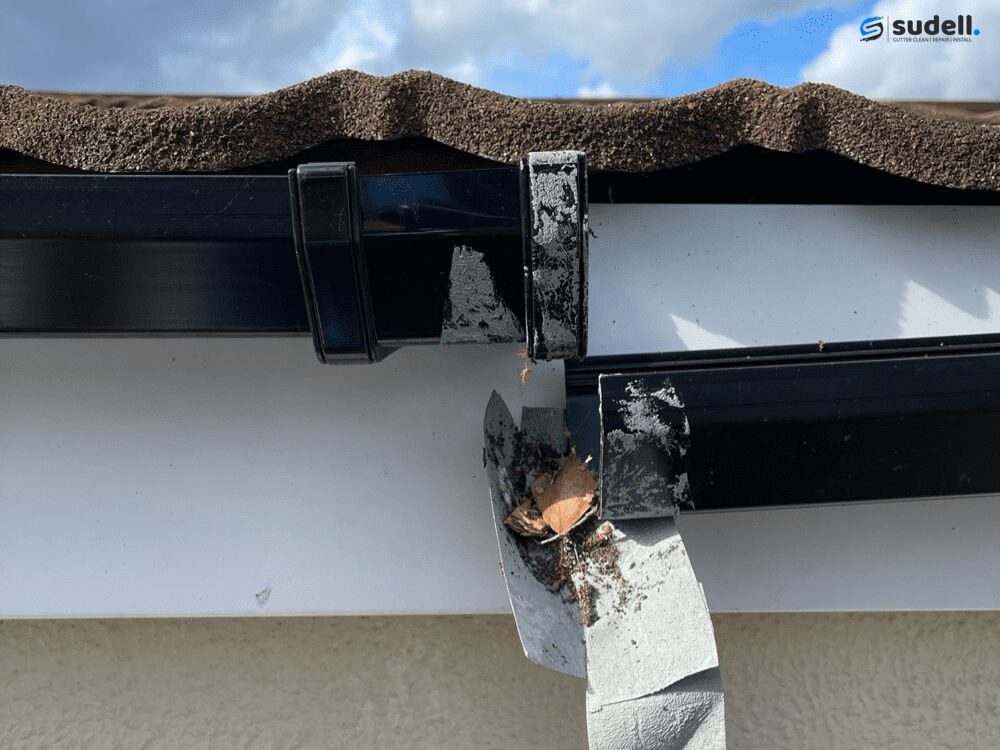
Sudell Gutter Cleaning has a reputation for fixing leaking and damaged gutters quickly. Our gutter repair service is always in high demand as we are one of the few companies that will provide you with 12 months guarantee* for any gutter repair we fix giving you confidence and peace of mind. We have fully stocked vans with spares so we are always ready to fix gutters in record time.
Gutter Installation
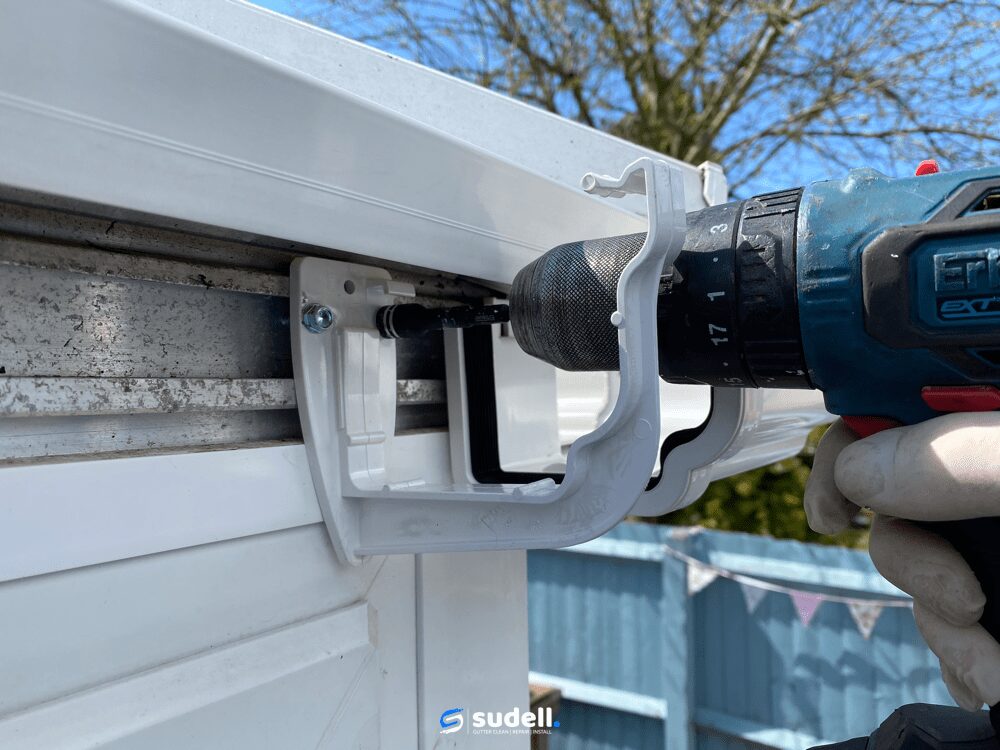
A new rainwater guttering system installed to perfection. Sudell Gutter Cleaning are registered installers of FreeFoam Plastics allowing us to supply and install quality uPVC gutters and down-pipes to the highest standard. All new installations are guaranteed for peace of mind.
Commercial Gutter Cleaning
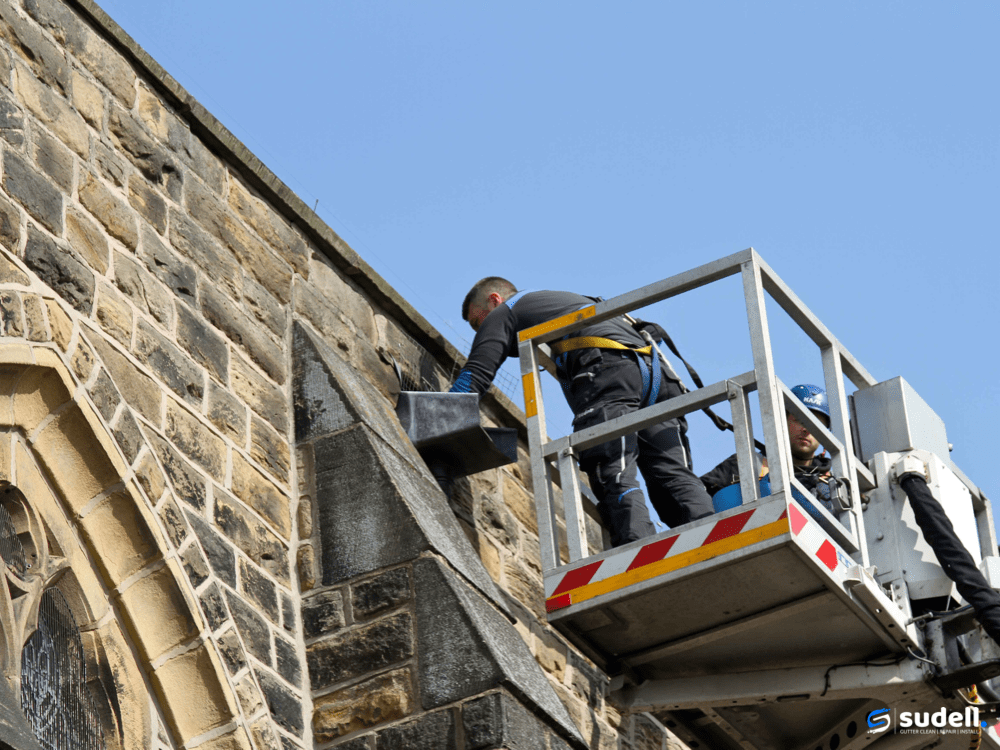
Professional gutter cleaning and repair maintenance for commercial properties including churches, schools, warehouses, and offices. Health and safety compliant. We complete and supply risk assessments and method statements.
Water Butt Installation

As Featured in the Guardian, The Times and the Sunday Times.
We supply and install the prestigious wall mounted, slim line water butt. A water butt that actually works and helps us all reduce our carbon footprint. Learn more.
Gutter Guards
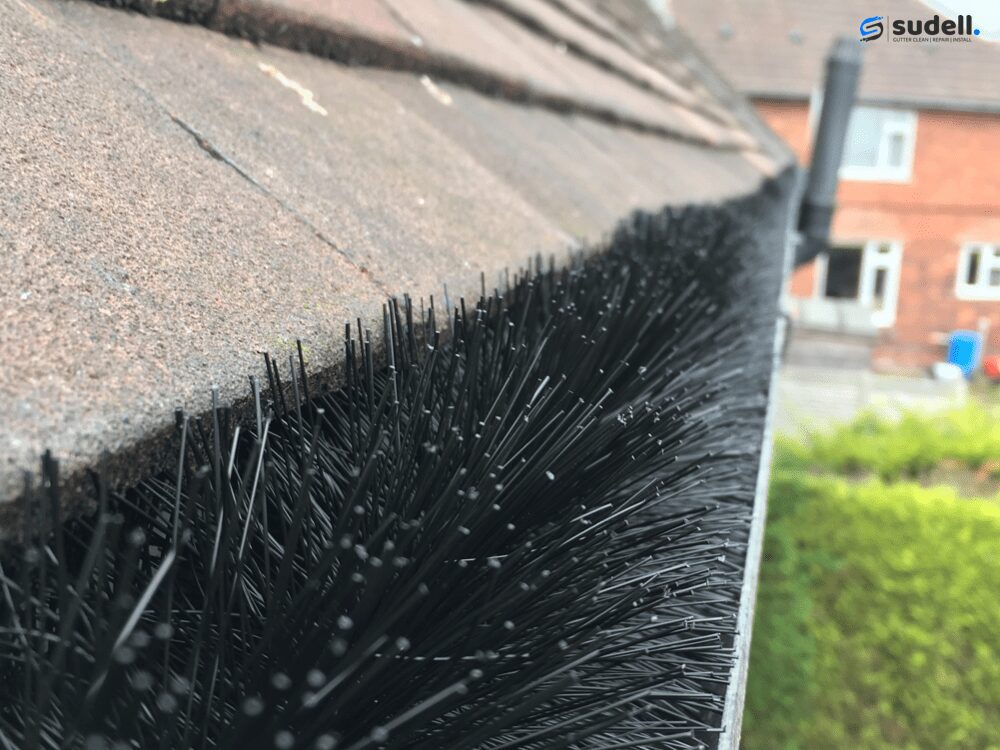
Gutter guards suitability check and installation service, Sudell Gutter Cleaning will check to see if gutter guards will actually work before you spend your hard earned cash on them. We have over 10 years experience in gutter maintenance with valuable knowledge in gutter guard protection.
Gutter Talk….
Read our latest blog posts full of useful, regularly updated information. [See All]
✨ Sudell’s Community Clean-Up Day: Giving Road Signs Their Shine Back ✨ Did you know that once a month, Sudell’s Hot Wash team carries [...]
5 Tips for Winter Gutter Maintenance As winter approaches, your gutters face their toughest test — heavy rainfall, falling leaves, and freezing nights. Annual [...]
Gutter cleaning is dangerous Working at height Ladder Training / Experience Unsuitable equipment Wildlife Bacteria/Infection Ladder Training and Experience Working at height is [...]
Damp can appear in the winter due to several reasons such as cold temperatures, lack of ventilation, leaks, poor insulation and low heating [...]
Warning: The Hidden Dangers of DIY Gutter Repair! Untrained Fixes Could Cost You More Than Just Money! Welcome to our latest blog post where we [...]
Spring gutter cleaning stops plants from taking root, prevents damage from growing roots, and keeps your gutters working properly. Catch issues early, and avoid costly [...]
The Truth About Gutter Cleaning Costs in the UK: Is It Worth It? Ah, gutters. The unsung heroes of your home, tirelessly catching rainwater, [...]
✨Introduction✨ “The GUTTER Drip That Just Won’t Quit” You’re all set for a good night’s sleep. The lights are off, [...]
FREE Multi-Point Gutter Check Claim your FREE Multi-Point Roof & Gutter Check completed by a trained technician. BOOK NOW [...]
Chapter 1: Understanding the Importance of Gutters Congratulations on your new build home! As a new homeowner, you have a beautiful, pristine property that [...]
Do Gutter Guards Work?… A Comprehensive Guide Introduction Gutters play a crucial role in protecting your home from water damage. However, their maintenance often [...]
Hire A Gutter Specialist! Get a repair guarantee! It’s Your Hard Earned Cash! Why would you use your hard earned cash to pay for [...]
Recent Work….
Noteworthy jobs that we have recently completed. [See All]
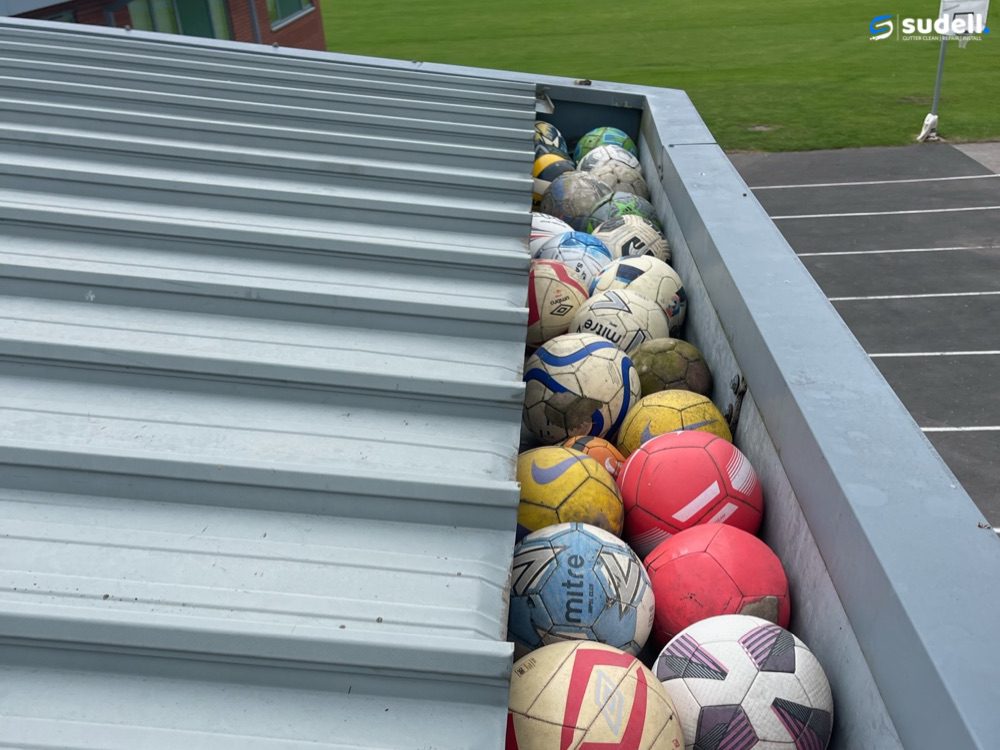
School Gutter Cleaning and Repair: A Safe and Successful Project by Our Burton Team
At our company, we take pride in our commitment to delivering top-notch maintenance and repair services, and a recent project at a local school in Burton showcases our dedication to excellence. In this comprehensive portfolio post, we will highlight our successful gutter cleaning and [...]
Latest Questions & Answers….
Check out our help centre where we answer some of the most common questions.
- Conservatory Gutters
- Damp
- General
- Gutter Cleaning
- Gutter Guards
- Gutter Problems
- Gutter Repairs
- How to
- Parapet Wall
- Roof Cleaning
- Water Butts
Can leaking gutters be repaired?
Leaking gutters can often be repaired successfully. The most common gutter problem is a leaking gutter joint. Gutter joints can usually be repaired by either replacing the joint, replacing the seals, or by completing a expert repair using a low-modulus, waterproof sealant that remains flexible when fully cured.
Is gutter cleaning worth it?
Yes, gutter cleaning is worth it. Regular gutter cleaning will prevent blockages in your gutters, downpipes and drains. It will also prevent leaks and damage caused by the extra weight that the debris adds to the gutter. Gutters that overflow or leak can cause water damage to the property and foundations such as internal leaks, damp, decay, and mould.
Did you know, some insurance companies have conditions within their policies that require proof of regular gutter cleaning maintenance.
| Specification | Info |
|---|---|
| Item dimensions L x W x H | 46 x 23 x 122 centimetres |
| Capacity | 100l |
| Installation | Wall Mounted |
| Colours | Granite White / Slate Grey / Black / Sandstone |
Yes! Our innovative techniques allow us to clean gutters over parapet walls on four-story buildings without the need for traditional access equipment like scaffolding, ladders, or Mobile Elevating Work Platforms (MEWPs). We utilize custom-designed tools and methods that ensure efficient and safe cleaning with minimal disruption.
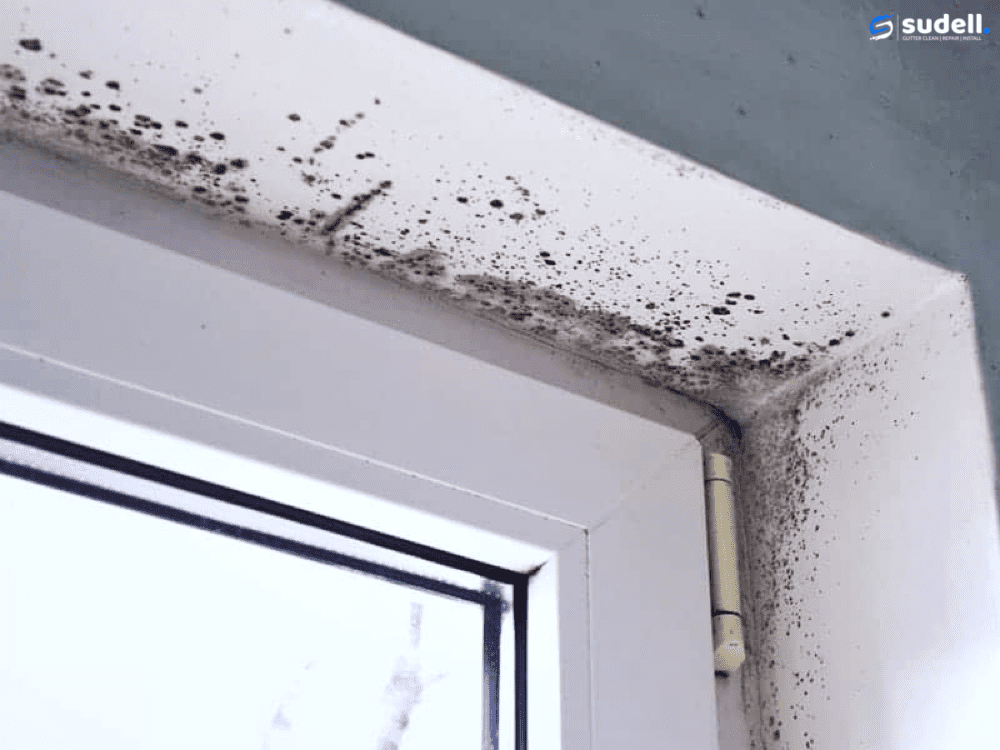
What is Condensation?
Condensation occurs when water vapor in the air turns into liquid droplets on a surface that is cooler than the air. This happens when the air becomes saturated with water vapor and the temperature drops, causing the water vapor to condense into liquid droplets.
What causes condensation in my house?
Condensation can happen in a house for several reasons:
- High humidity: If the humidity level inside your home is high, the air will be more likely to reach its saturation point and condense on cooler surfaces.
- Lack of ventilation: Poor ventilation can trap moisture inside the house, increasing the humidity level and leading to condensation.
- Temperature differences: If there are significant temperature differences between different areas of the house, such as between the walls and the windows, the cooler surfaces will be more likely to condense moisture.
- Lack of insulation: Insulation helps to keep the temperature inside the house more consistent and reduces the chance of condensation forming on the walls and windows.
- Cooking, cleaning and showering: These activities can generate a lot of moisture and can cause condensation if the humidity level inside the house is high and the ventilation is poor.
- Leaks: leaks can also cause condensation. If there is a leak in your house, the water will cause condensation on the walls and ceilings.
How do I prevent condensation in my house?
There are several steps you can take to prevent condensation in your home:
- Control humidity: Use a dehumidifier or air conditioner to keep the humidity level inside your home at around 50%.
- Ventilate: Make sure to ventilate your home properly by opening windows and using exhaust fans in the bathroom and kitchen to remove moisture.
- Insulate: Insulate your home to keep the temperature inside more consistent and reduce the chance of condensation forming on the walls and windows.
- Seal leaks: Find and seal any leaks in your home to prevent moisture from seeping in and causing condensation.
- Use extractor fans: Use extractor fans in the kitchen and bathroom to remove moisture-rich air while cooking, cleaning or showering.
- Wipe surfaces: Wipe down surfaces that have condensation regularly to prevent mold and mildew growth.
- Keep warm: Keep your home warm during cold weather, as cold walls are more likely to condense moisture.
- Dry clothes outside: if possible, dry clothes outside instead of inside the house to reduce moisture.
By following these steps, you can help prevent condensation in your home and keep your living environment healthy and comfortable.
What are the signs of condensation?
Condensation can appear on a variety of surfaces, including:
- Windows: Windows are often the first place where condensation is noticed, as the glass is often cooler than the air inside the house.
- Walls: Condensation can also form on walls, especially if the walls are not well insulated or if there is poor ventilation.
- Ceilings: Condensation can also form on ceilings, particularly in rooms with high humidity levels, such as bathrooms and kitchens.
- Pipes: Pipes, particularly those in unheated areas of the house, such as the attic or basement, can also develop condensation.
- Furniture: Condensation can also form on furniture, such as on the surfaces of wood or metal, if the humidity level inside the house is high.
- Cold surfaces: Condensation can appear on any surfaces that are colder than the air, such as metal, plastic, painted surfaces, etc.
It’s important to note that condensation can appear anywhere in the house and it can be a sign that the humidity level is too high or the ventilation is poor, and it can lead to mold growth if not addressed.
Further Reading
Axa – What causes condensation and how to stop it
Sudell – What is penetrating damp?
Sudell – 12 Tips to Prevent Damp in Your Home This Winter
Yes, our gutter cleaning approach is especially cost-effective for buildings with parapet walls. Traditional cleaning methods can be particularly expensive for such structures due to the complexities involved in accessing the gutters. Scaffolding must be built to a greater height and requires additional safety measures to navigate the parapet, while the use of Mobile Elevating Work Platforms (MEWPs) can be limited by the surrounding terrain or urban environment.
Our specialised method utilises custom-designed equipment to access and clean gutters behind parapet walls without the need for extensive scaffolding or MEWPs. This specialized equipment includes extendable tools and camera systems that allow our technicians to efficiently clean the gutters from the ground or a lower level, avoiding the high costs associated with the setup, rental, and labor of traditional access equipment.
Furthermore, since buildings with parapet walls often present a challenge for regular maintenance checks, our method includes the use of inspection cameras that can confirm the gutters are clear without additional access equipment. This means that routine checks can be carried out quickly and inexpensively, ensuring the gutter system remains in optimal condition and potentially avoiding the costs associated with emergency call-outs for blockage removal.
By reducing the need for heavy equipment and minimizing the time required to complete the cleaning, we offer a solution that is not only more cost-effective but also minimizes disruption to the building’s occupants and operations. This streamlined process allows for more frequent maintenance, which is essential for the longevity of gutters on buildings with parapet walls. In the long term, regular, efficient cleaning protects the building’s structural integrity and aesthetic appearance, providing cost savings on potential repairs and maintenance.
How do you know if your downpipe is blocked?
It may be a sign that’s your downpipe is blocked if your gutters are overflowing or if there is very little rain water coming through the downpipe. You may even see a wet or damp wall which is caused by the blockage.
Downpipes can get blocked by any debris that washes into the gutter from the roof which can block in the gutter outlet, in the swan neck, in the downpipe itself, or in the drain.
Common downpipe blockages are caused by roofing debris such as broken tiles and mortar, gutter debris such as moss and leaves, and foreign objects such as birds and tennis balls.
Do gutters need to be cleaned if there are no trees?
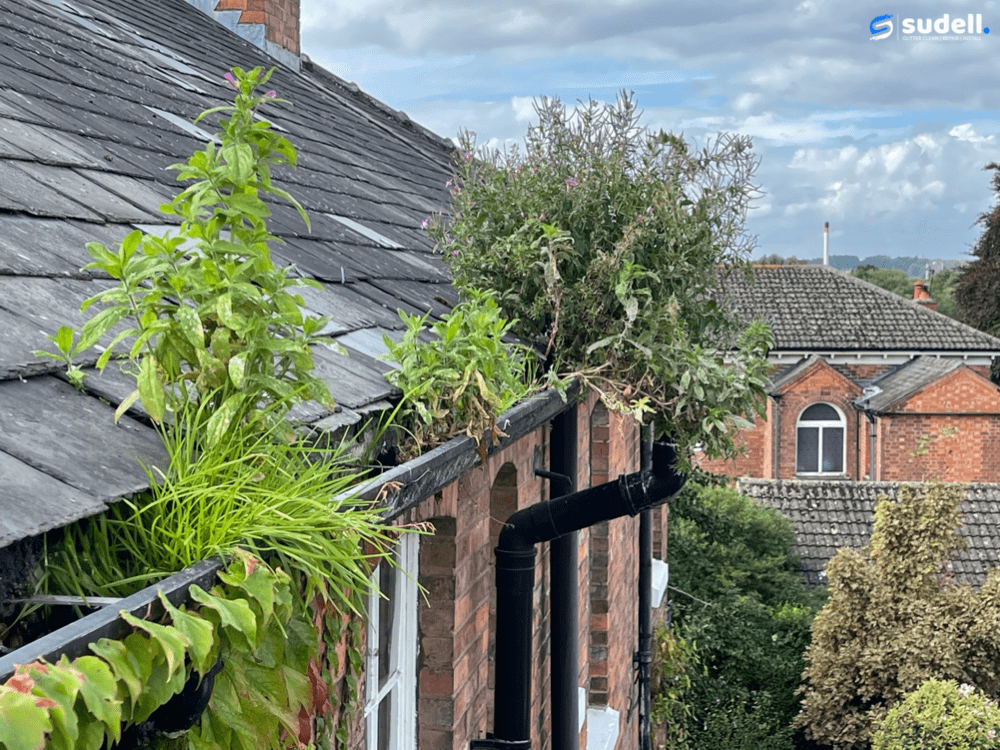
Gutters are an essential component of any home’s exterior, as they channel water away from the foundation and prevent leaks and water damage. While many homeowners may think that gutters only need to be cleaned if there are trees nearby, this is not the case. In fact, gutters should be inspected and cleaned regularly, regardless of the presence of trees.
One of the main reasons why gutters need to be cleaned even if there are no trees nearby is that they can still accumulate debris. Dust, dirt, and other debris can collect in the gutters over time, reducing their effectiveness and potentially causing clogs. This can lead to water overflowing and potentially causing damage to the home’s foundation and exterior.
Another reason to clean gutters even if there are no trees nearby is that it can help prevent leaks and water damage. When gutters are clogged, water may not flow properly, causing it to overflow and potentially seep into the home. This can lead to leaks, water damage, and even mold growth. Regular cleaning of the gutters can help prevent this from happening by ensuring that water flows properly through the gutter system.
Lastly, cleaning gutters is also important for maintaining the overall appearance of your home. Dirty and clogged gutters can make the exterior of your home look unkempt and can detract from its overall aesthetic appeal. Regularly cleaning your gutters can help maintain the appearance of your home and ensure that it looks its best.
In conclusion, even if there are no trees nearby, gutters still need to be cleaned regularly to ensure that they function properly and prevent water damage, leaks and mold growth. Regular cleaning can also help maintain the appearance of your home and keep it looking its best. It is recommended to inspect and clean gutters at least twice a year, or more frequently if you live in an area with heavy rainfall or other weather conditions that can affect the gutters.
It depends on the size, shape, and condition of your roof. But don’t worry — we’ll give you a proper inspection and a clear, honest price. No hidden extras, no pressure.
Your house could develop an unpleasant smell if your clogged gutters result in damp, mould and/or rot. If the gutters cannot divert rainwater away from the property effectively and instead leaks or overflows, it can cause penetrating damp which is a breading ground for mould. Rotting wooden fascias, soffits, barge boards, and window sills can also release unpleasant smells and attract insects.
Furthermore, if your gutters fill up with bird poop, it can give off very nasty smells, especially on hot sunny days.
5 things you can do to fix rain running behind the gutter:
- Install eves protection boards which slide under the end course of roofing tiles and under the roofing membrane. Eves protection boards support the roofing membrane under the roof tiles to prevent ponding. The eves boards lip neatly into the gutter to prevent water from running between the gutter and fascia board. Eves boards are particularly good if your roof do not extend over the gutter far enough.
- Make sure the roofing membrane is not trapped behind the gutter and is instead position in the gutter.
- Fix any broken roof tiles and reposition any that need adjustment.
- Resecure loose fascia’l boards and gutters back to the property.
- Clean out gutters and unblock outlets downpipes and drains so rainwater can drain away from the property accordingly.
You don’t necessarily need to empty a water butt providing you keep the water moving with regular fresh rainwater. You could consider adding a water butt treatment especially if your water butt is positioned in direct sun light, or it doesn’t get used frequently. If you don’t use your water butt frequently it would be a good idea to empty the water butt every 10 days to keep the water fresh.
We stand by our work. You’ll get a clear breakdown of what to expect based on your roof type, and we’re always happy to return if anything isn’t right. Our reputation matters — and we protect it by doing things properly.
Can my gutters overhang my neighbours?
Disputes with your neighbour about guttering can be frustrating. The law states that you technically own the airspace above your property, so if your neighbours gutter overhangs onto your property, they are technically trespassing. If the gutters have no right to be there you can insist upon their removal. If your neighbour refuses your request, the courts have the power to order an injunction for their removal. This should be the last resort and speaking to your neighbours first will usually resolve the problem.
There are some situations in which your neighbours overhanging gutters may be permitted by law:
- The deeds specifically provide a right for them to be there.
- If the overhanging gutters have been there for more than 20 years, they may have a prescriptive right to be there through long-term usage.
- If they have been there for more than 12 years, then it may be possible for your neighbour to acquire ownership of the airspace that they occupy.
- If they have been there for some time or were built that way as part of a development, it may be argued that the land bought also included the airspace into which the gutters overhang. This may mean that the boundary line above the ground is slightly different to the one on the ground so that the overhanging gutters can remain.
What is the easiest way to clean gutters?
The easiest way to clean gutters is to hire a professional to clean the gutter for you.
If you choose to clean your gutters yourself, the easiest way to clean gutters is with a ladder and a bucket.
Use a ladder limb to safely hang your bucket from. Scoop the debris out by hand ensuring you are wearing suitable gloves.
For best results, use a damp sponge or cloth to push the remaining slurry along the gutter to leave it clean. Set up your ladder in the next position within arms reach of the previous one. Continue to scoop out the debris by hand before pulling the damp sponge towards you again.
Repeat this process until you reach the end of the gutter. Do not push any debris down the downpipe! You could block the downpipe or drain!
That depends on your roof, but with a professional biocide treatment, you can expect 2 to 5 years of protection. We’ll inspect your roof and recommend the best approach for long-term results — not just a quick fix.
Why is my conservatory gutter leaking?
Conservatory guttering is usually very different from the standard guttering that you would find on your house.
A conservatory gutter is attached to a ring beam which sits level on top of the conservatory window frames.
There is no adjustment in conservatory gutters as they will generally follow the level of the conservatory.
Over time conservatories can settle which can cause conservatory gutters to drop, preventing rain water from draining away accordingly.
Many conservatory gutter parts are no longer made and are therefore not available to buy. When this occurs the only options available is to try and repair the existing gutters or to replace them.
Replacing conservatory gutters can be a really good option when completed by an experienced installer.
It costs nothing to collect and store a constant supply of rainwater to use (other than the initial cost of the water butt).
It is absolutely worth having a water butt!
Having your own water butt will allow you to collect and store rainwater to use on your plants and around your garden.
Water butts help us reduce our carbon footprint by using less tap water which requires a tremendous amount of energy to treat. Furthermore, it can help you save money on your water bill.
It’s worth noting that rainwater is much better for your garden than tap water, which contains chemicals such as chlorine and fluoride.
Yes — and not just because it looks bad. Moss soaks up water like a sponge, forcing it under your tiles and causing damage over time. It also clogs up your gutters, increases the risk of damp, and shortens the life of your roof. The longer you leave it, the more it costs to fix.
Is it normal for gutters to overflow in heavy rain?
Overflowing gutters in heavy rain may be a sign that your guttering system is inadequate or has been installed poorly.
If your property does not have enough downpipes the guttering may not be able to cope with large amounts of rainwater and remove it from the gutter quick enough. The more downpipes you have will increase the ability for the rainwater to be drained quickly and prevent overflowing.
A lager profile of gutter such as an Ogee or deep flow profile will hold more rainwater giving the system more time to drain without overflowing. More and more properties are now being fitted with larger guttering profiles to cope with heavy rainfall we experience regularly in modern times.
Related
How do I stop my gutters from leaking?
Your gutters could be leaking for a number of reasons. To stop your gutters from leaking you first need to determine why they are leaking.
Your gutters could be leaking due to:
- Blockages in the gutter.
- Failing gutter joint seals.
- Movement in the gutter.
- Poor gutter alignment.
- An old degraded guttering system.
- Insufficient gutter capacity.
- Poor installation.
- Lack of gutter supports.
You can fix many gutter leaks by cleaning out the gutters, outlets and downpipes and replacing fault gutter joints.
Why does water run behind my gutters?
If rain is running behind your gutters it is sign that your roof and guttering system has a fundamental problem.
The five most common reasons rain could be running behind your gutter are because:
- The end tiles do not extend over the gutters far enough.
- Roofing membrane is trapped behind the gutter.
- Broken or misaligned roof tiles.
- Insecure gutter or fascia board pulling away from the building.
- The gutters are blocked and overflowing
End tiles not overhanging the gutter
If your end roof tiles do not extend into the gutter far enough, rainwater can run between the gutter and the fascia board. This can occur if you have installed a uPVC fascia capping board over the top of an existing fascia board. This would move the gutter further away from the end roof tiles which could cause water to run behind the gutter.
Roofing membrane trapped behind the gutter.
A roofing membrane is usually installed underneath your roofing tiles to create a water tight covering. The roofing membrane should finish by lipping into the gutter. If the roofing membrane is trapped awkwardly behind the gutter, it could direct water behind the gutter.
Broken or misaligned roof tiles.
Broken tiles can cause water to run beneath the roof which could cause water to run behind the gutter. Furthermore, misaligned tiles particularly the end tiles can create gaps for water to run behind the gutter.
Insecure gutter or fascia board pulling away from the building.
A damaged gutter or fascia which is not secure to the building can cause water to run behind the gutter.
Blocked gutters
Blocked gutters can cause rainwater to overflow over the front and back edge of the gutter.
Related
Can snow and ice damage gutters?
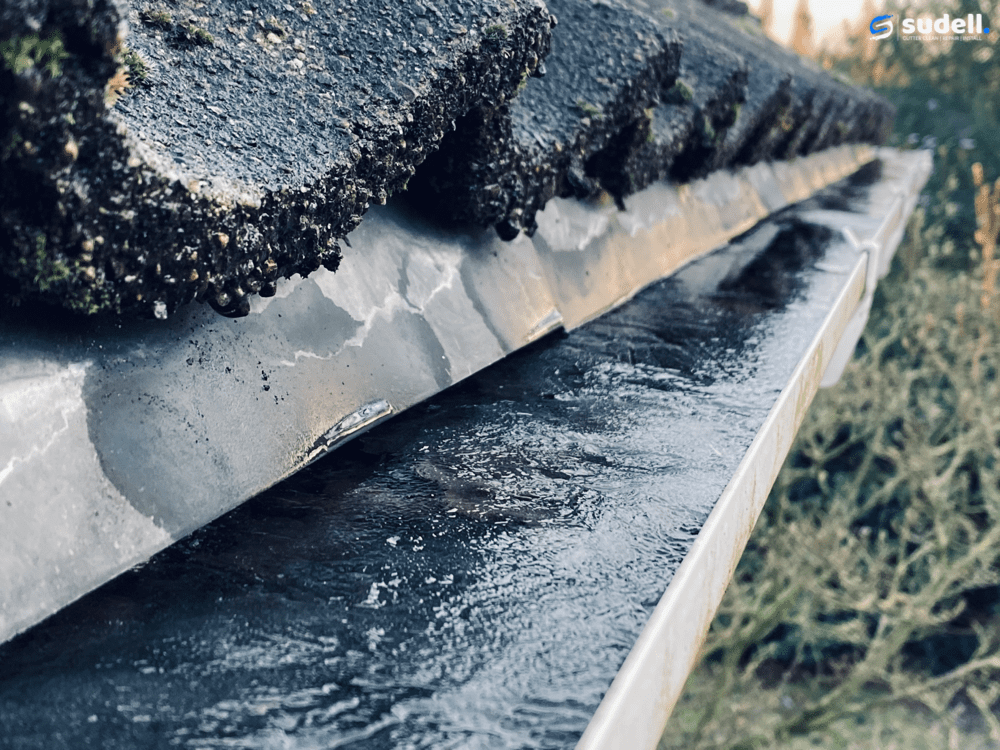
Ice in gutters can damage gutters and gutter joints because as the ice expands, it puts pressure on the gutters and the joints where sections of gutter are connected. The pressure can cause the gutters to bend, warp, or pull away from the home. Additionally, the freezing and thawing cycle can cause the joints to weaken and leak, which can lead to water damage to the home. When the ice becomes heavy enough it can also cause gutters to fall off or to fail completely.
Snow can also cause problems for the roof and gutters. When the snow melts and the water runs off the roof, it can cause pressure on the gutter hangers, which are the brackets that hold the gutters in place. If the hangers are not properly secured or are made of weak material they can bend or even break under the weight of snow and water, which can cause the gutters to sag or fall off altogether.
Furthermore, heavy snow can also cause damage to the roof itself, which can lead to leaks and water damage inside the home. If the roof is not able to support the weight of the snow, it can cause structural damage and even collapse. This can in turn put added pressure on the gutters, exacerbating any damage they may have already sustained.
It’s important to have regular gutter maintenance and snow removal to prevent this kind of damage. And if you live in a area where heavy snowfall is expected it’s a good idea to have a professional inspect and possibly reinforce the gutters and roof before the winter.
The frequency of gutter cleaning for buildings with parapet walls can vary depending on several factors, such as the building’s surrounding environment, the amount of debris typically encountered, and the region’s weather patterns. However, a general guideline is to perform gutter cleaning at least twice a year. This is often scheduled for the spring and autumn, when gutter blockages are more likely due to fallen leaves and increased rainfall.
In areas with dense foliage or those prone to frequent storms, it may be prudent to increase this frequency to four times per year to accommodate the additional debris and potential for heavy downpours. Regular maintenance ensures the gutter system remains clear and functional, preventing water overflow that could lead to structural damage, dampness, or the growth of mold and mildew.
Buildings with parapet walls should be given particular attention as the gutters may not be as accessible for regular checks and the parapet can conceal accumulating debris. Consistent cleaning helps to avoid the build-up of materials that could cause blockages, thereby maintaining the integrity and longevity of the building’s drainage system.
Additionally, after extreme weather events or atypical seasons with higher than average debris fall, inspections and potential cleanings should be considered. Ultimately, the aim is to ensure the gutter system does not become compromised, thereby safeguarding the property from water-related damage.
Is January a good month to clean out gutters?
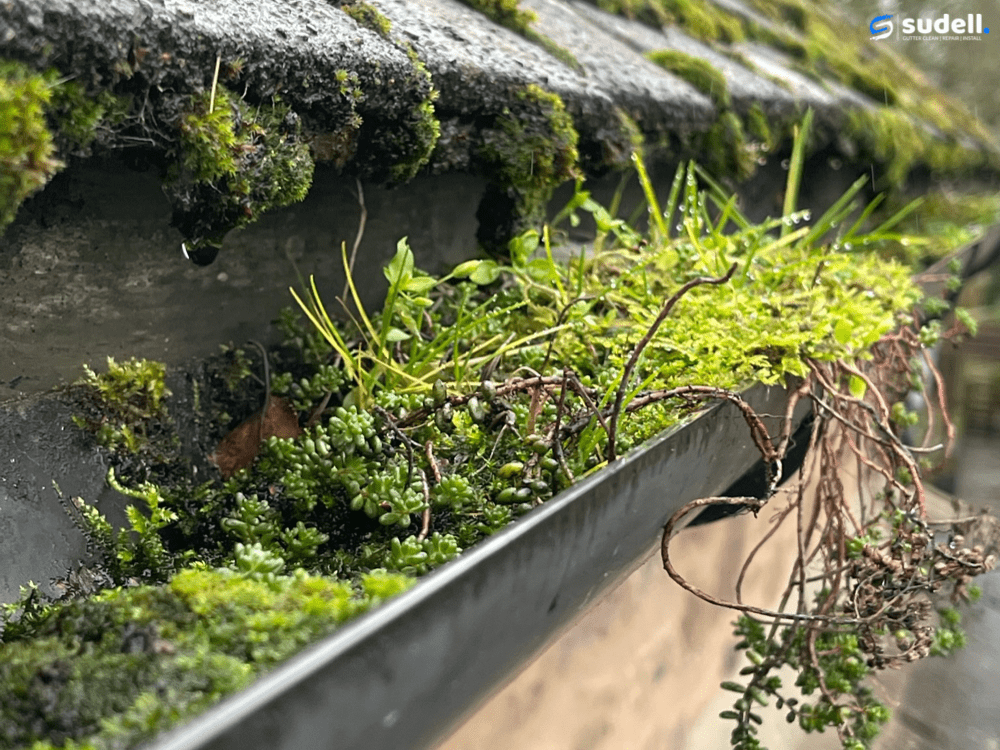
January is the perfect time of year to clean out your gutters! As the holiday season comes to a close and the New Year begins, many homeowners are looking for ways to start fresh and get organized. Cleaning out your gutters is the perfect way to kick off the new year and ensure that your home is in top condition.
One of the main reasons why January is the perfect time to clean out your gutters is because the leaves have fallen from the trees. During the fall, leaves can build up in your gutters, clogging them and causing water to back up. This can lead to water damage and other problems if not addressed. By cleaning out your gutters in January, you can ensure that they are clear and ready to handle the spring rains.
Another reason why January is a great time to clean out your gutters is because the weather is generally mild. During the winter months, the weather is not as harsh as it is during the summer, making it easier and safer to work on your gutters. You won’t have to worry about heat exhaustion or sunburn while working on your gutters in January.
Finally, cleaning out your gutters in January can help you get a jump start on your spring cleaning. By tackling this task early, you’ll be able to cross it off your list and have one less thing to worry about as the weather starts to warm up.
In summary, January is the perfect time of year to clean out your gutters. The leaves have fallen, the weather is mild, and it’s a great opportunity to get a jump start on your spring cleaning. Don’t wait until it’s too late, take advantage of the mild weather and get your gutters cleaned out today!
Regular maintenance of gutters with parapet walls is essential because these structures can create unique challenges for water drainage. Parapet walls can hide gutters from view, making it easy to forget about regular cleaning and inspections. Because the gutters are not directly exposed to the elements, they don’t benefit from the natural cleaning effects of rain and wind, which can help clear out gutters that are more open.
Moreover, leaves, twigs, and other debris can accumulate more rapidly in these concealed gutters. When debris collects, it can lead to blockages that impede water flow, potentially causing overflow, which can then result in water infiltration into the building. This can lead to dampness issues, damage to both the interior and exterior of the structure, and may also accelerate wear on the roofing materials.
In addition, since parapet walls are typically part of the building’s aesthetic, improper maintenance of the hidden gutters can eventually detract from the building’s appearance if dampness and overflow issues are not addressed.
Therefore, regular maintenance ensures that the gutters function properly by:
- Preventing water damage to the building’s façade, roof, and foundation.
- Avoiding mold growth and dampness that can affect the building’s interior.
- Ensuring the longevity of the gutter system and the overall building envelope.
- Maintaining the aesthetic integrity of the building’s appearance.
For these reasons, it is recommended to schedule gutter cleaning and maintenance more frequently for buildings with parapet walls, and to have these services performed by professionals who have the expertise and equipment to deal with the added complexities of such structures.
What is the most common problem with gutters?

The most common problems with gutters are:
- Blocked gutters, outlets and downpipes
- Leaking gutter joints
- Perished joint seals
- Insufficient gutter capacity
- Poor drainage due to gutter alignment
- Not enough downpipes installed
- Gutter cut too short
- Lack of gutter supports installed
- Gutter joints not secured to the fascia board
- Old narrow gutter joints not allowing sufficient expansion
Related
Our service is tailored to minimize disruption by using advanced, compact equipment that eliminates the need for extensive setup typical of traditional methods. Parapet walls, which can complicate access due to their height and design, often require more invasive procedures like scaffolding or MEWPs, leading to potential disturbances. We address this by employing extendable poles and camera systems that enable our technicians to efficiently clean from ground level or lower roofs, significantly reducing the time and space needed on-site. Our quiet and rapid cleaning process ensures the daily routines of building occupants are maintained without compromise.
Does gutter cleaning include downpipes?
A good gutter cleaning company should always clean the outlets and downpipes as part of a gutter cleaning service.
Sometimes downpipes need removing to unblock them properly which the gutter cleaning company should advise you and may charge extra for this.
Sudell gutter cleaning unblock downpipes as standard if it is possible to without removing the downpipe. We may charge a little extra if we need to remove the downpipe or require access to the drain.
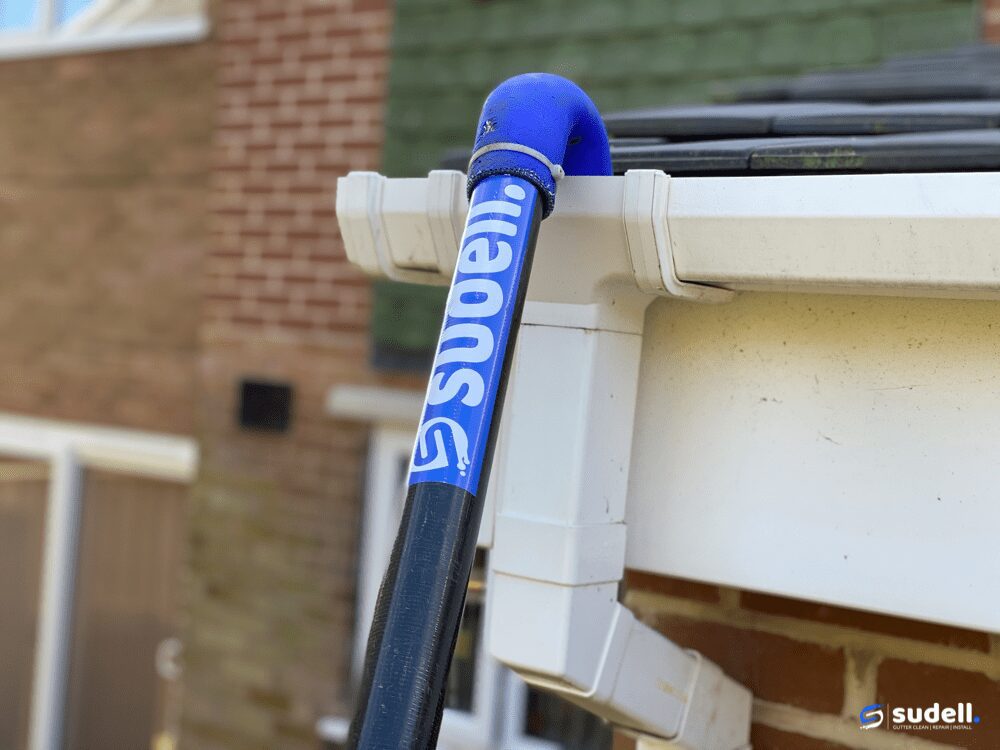
Is there a downside to gutter guards?
The disadvantages of gutter guards.
- Gutter guards can be expensive to buy and can cost even more if you need to hire someone to install them for you.
- Debris can sit on top of the guards and create a barrier preventing rainwater from draining into the gutter properly.
- When it’s time to clean the gutters, It takes longer to complete because you have the added task of removing the guards, cleaning the guards and putting them back in once you’ve cleaned the gutters.
- Storms can blow gutter guards out of the gutter.
- Fine debris can get through the guards and build up over time and create blockages.
- Gutter guards don’t stop vegetation from growing in the gutter because silt and seeds are small enough to get through them and into the gutter.
- Many gutter guards trap debris instead of diverting it.
Why has my gutter fallen down?
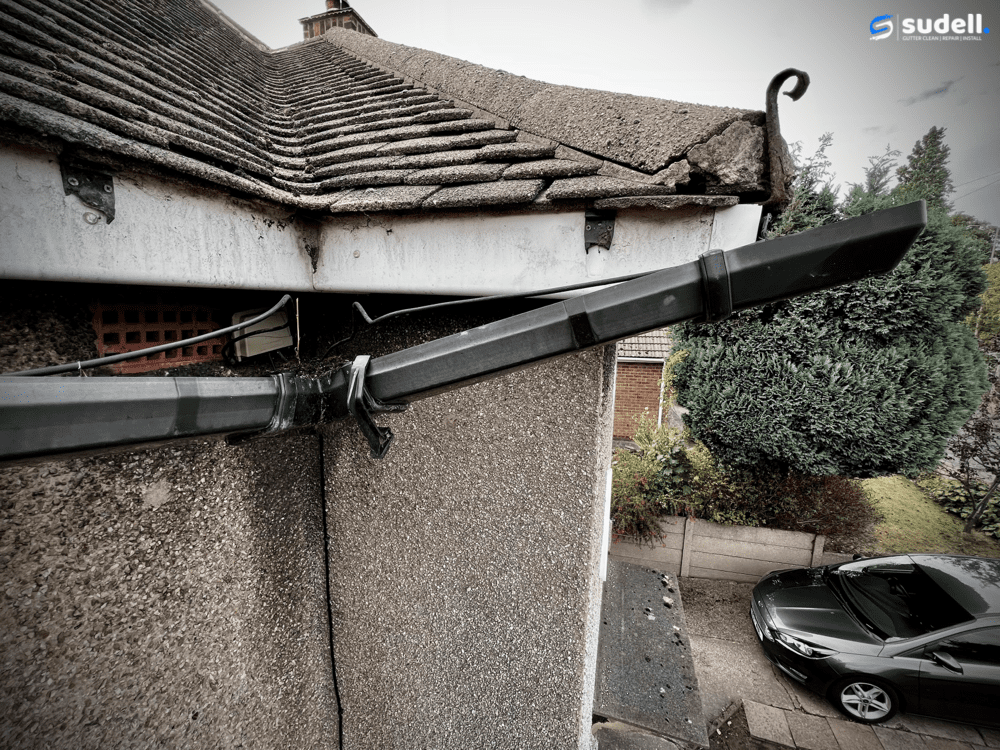
A falling down gutter is a common problem and can sometimes be avoided.
The reason why your gutter has fallen down may be because,
- Your gutters were full of debris and the additional weight has pulled the gutter down.
- The wrong type or size screws/fixings were used when originally installed which have either eroded over time or have pulled out of the wall.
- You do not have enough gutter brackets installed to support the gutter appropriately.
- Recent work completed by a friend or family member resulting in accidental damage to the gutter.
- You have been resting your ladder against the gutter inappropriately.
You should contact your local gutter expert to fix a gutter that has fallen down who will be able to complete the repair properly and safely.
How do you clean gutters between a house and conservatory?
The gutter between your house and conservatory can fill up with debris quickly and should be cleaned out more regularly.
It’s best to hire an experienced gutter cleaning professional that has the correct tools and equipment to clean out gutters between a house and conservatory.
A box valley gutter is usually quite wide in which debris can get stuck directly under the roof. A gutter vacuum can help suck out all the debris without needing to climb on to the roof which could cause damage. If you do not have access to a gutter vacuum, you can complete the gutter cleaning by hand with a micro fibre cloth and a bucket.
First remove as much debris from the gutter as possible. Next, place the micro fibre cloth into the gutter and push the remaining debris to the opposite side of the gutter so it can be collected at the end of the gutter. Rinse the gutter through with clean water. Do not push any debris into the downpipes as this could block the drains.
Related
How do you clean gutters over a conservatory?
The best way to clean out gutters over a conservatory is by using a powerful gutter cleaning vacuum system. Our gutter cleaning vacuum combined with our lightweight carbon fiber poles can reach gutters up to 40ft high, with an outreach of approximately 6 meters. This enables us to reach into the gutters above your conservatory to clean out the debris. This is much safer than using a ladder to which could be dangerous if trying to reach over the conservatory to clean it out. Furthermore, a gutter vaccum will be much more effective at removing the gutter waste.
Planning out your gutter cleaning job is important. Before cleaning out the gutters above your conservatory, the professional will check your gutters for large debris such as damaged roofing material and mortar which could damage the conservatory roof if not removed carefully. What’s more, we can remove large chuncks of debris from your gutter safely and with ease.
Conservatory snow guards
Conservatory snow guards can make it a little more difficult to clean out the gutters above conservatories. Snow guards extend above the gutter limiting access into the gutter. At your service we have a number of vacuum extension tools that allow us to access gutters with snow guards in order to clean them out.
How often should you clean out gutters above conservatories?
We recommend cleaning out gutters above conservatories twice per year to prevent blocklages in the gutter which could lead leaks and damage that could result in expensive repairs.
Related
- How to clean gutters between a house and a conservatory
- Conservatory gutter replacement
- How to fix conservatory gutters
That’s absolutely fine. Some roofs just need a scrape, others just a treatment. We don’t upsell — we advise. You’ll get a service tailored to your roof, your budget, and your goals. Simple.
Should a downpipe go into a drain?
The guttering and drainage system on your property is important as it protects your property and the environment around it.
But where does the rainwater go when it enters your downpipe?
A downspouts role is to drain rainwater into a public drainage system or into a purpose made soak-away. The regulations state that a rainwater soakaway must be located at least five metres from the wall of a building and at least two and a half metres from a boundary.
Furthermore, a downspout should not allow water to pour at the base of the wall which could cause damage to the property and foundations over time.
A guttering system and the use of downpipes and drains can vary depending on the age, size and type of the property. Some semi detached, terrace and town houses share a Downpipe which should run into a designated drain.
Over the lifetime of a property, old guttering systems may have been replaced and drainage routes could have also been altered without consideration. Drainage of rainwater is strictly controlled, and you should not install a drain yourself without checking regulations.
What is considered too cheap for gutter cleaning?
The saying goes, “You get what you pay for you pay for” meaning the service or thing that can be bought for a very low price probably isn’t very good.
Just like any other service, if a gutter cleaning service is priced too cheaply, it may be a sign that you are not going to get the service you anticipate. Here are some reasons why some businesses may be charging their gutter cleaning services too cheap.
- No insurance or inadequate insurance cover.
- Poor quality service.
- Lack of training and experience.
- Tax evasion.
It is good practice to obtain 3 quotes from businesses that have a good reputation and with plenty of positive reviews. Doing this will help you determine the average price of a good gutter cleaning service.
We don’t mess about with risky ladders or dodgy shortcuts. Our team uses specialist telescopic scrapers shaped to match your roof tiles, and low-pressure cleaning for stubborn areas — all done from the roof edge without anyone stepping foot on your tiles. It’s safer, cleaner, and much better for your roof in the long run.
What can change the cost of gutter cleaning?
Here is a list of reasons why the cost of gutter cleaning can vary;
Size of the property.
Height of the gutters.
Type and location of the gutters.
How difficult the job is to complete.
Access to the gutters.
Working methods required.
Type of debris to be cleaned out of the gutter.
How long ago it was last cleaned.
The risk factor.
Generally, the bigger the house, the more gutters there will be to clean out. The higher up the gutters are, the more difficult they are to access and clean, which also increases the risks associated with working at height. Likewise, gutters in awkward locations such as over conservatories and valley gutters, will cost more to clean out as they are more difficult to access and require more skill to reduce the risk of damage or injury.
A larger/deeper gutter will accommodate more debris. The cost will vary depending on whether the gutters can be cleaned out safely using a gutter cleaning vacuum, or if traditional gutter cleaning is required with a bucket and a ladder. The type of debris that needs to be cleaned out of the gutter will determine how quick and easy is will be to clean out the gutters. For example, wet, sludgy gutter debris or dense vegetation is harder to remove from the gutter than dry leaves.
If the gutters haven’t been cleaned out routinely, it is more likely that there will be more debris to remove. If a ladder or other access equipment is required, the ease of access to the gutter may also reflect on the price of gutter cleaning.
Penetrating damp is the circumstance when moisture is able to penetrate the exterior shell of a building and transfer the moisture from an external wall through to the internal wall. Unlike rising damp, penetrating damp can occur at any level within the property including through roofs, ceilings and walls. If the signs of penetrating damp are left untreated it can cause problems to the building structure and can result in significant damage to the fabric of your home.
Research suggests that people in damp homes are twice as likely to suffer from asthma when compared to those living in homes without damp problems.
Common sign of Penetrating Damp.
- Plasterboard damage. Blistered, cracked and flaking plaster and signs salting. Salting is water bringing natural salts found in the wall to the surface and will result in a fluff-like residue being found on the surface of the plaster or decoration.
- Localised dampness. Localised patches of damp in seemingly random locations that won’t dry out, no matter what technique you use.
- Mould growth. Visible signs of mould growth or the accompanying musty smell.
- Damaged internal decoration. Damp, discoloured patches on internal decorations and walls or discoloured tidemarks.
- Rotting floor timbers or skirting boards. If these show signs of wet or dry rot decay, penetrating damp is a very real possibility.
What is gutter debris?
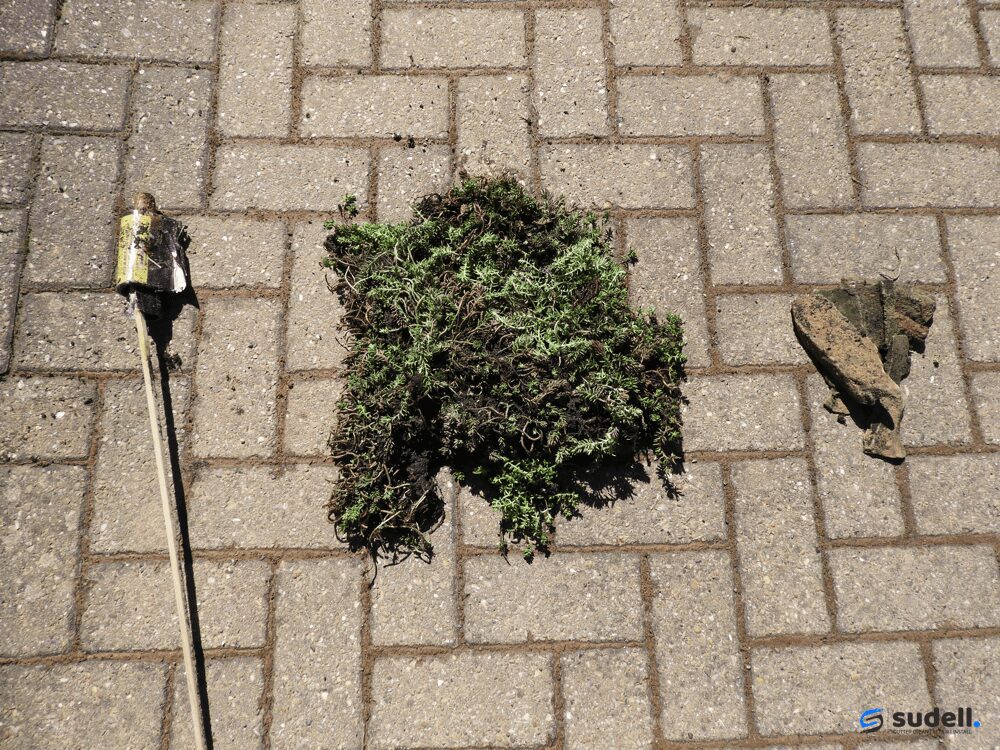
Gutter debris is material that ends up in the gutter such as leaves, moss, twigs, and broken roofing material. Debris is usually washed or blown into the gutters from the roof and can cause blockages in the guttering system. The type of debris that ends up in the gutter can vary depending on the type of roof, location and position of the property, the height and size of the property, and the weather conditions the property is exposed to.
The most common forms of gutter debris are:
- leaves
- moss
- pine needles
- silt
- roofing mortar / broken tiles
- grass
- plants / weeds
Less common types of gutter debris include:
- Discharged fireworks
- tennis balls
- dead birds
- Litter including empty wrappers, cans and bottles
- Dead insects including wasps and spiders
- Toys
Certainly! For gutters located behind parapet walls, where direct visual access is usually not possible, our cutting-edge camera technology becomes particularly valuable. We equip our cleaning equipment with advanced camera systems specifically designed to navigate the challenging and often hidden spaces of parapet gutter systems.
This technology facilitates real-time visual inspections, enabling our technicians to monitor and assess the condition of the gutters as they work. By providing live feed video, we can identify and target areas with significant debris build-up, such as leaves, twigs, or nests, which are common in the concealed spaces behind parapet walls.
The use of these cameras ensures that the cleaning process is not just guesswork. It allows for a precise and comprehensive cleaning regimen that is otherwise not achievable without a visual aid. Additionally, the footage from these cameras can be shared with building owners or managers, offering them peace of mind and transparency regarding the condition of their gutters.
This approach is particularly effective for parapet walls since it negates the need for repeated manual checks that would otherwise require temporary access solutions. It is an efficient and less intrusive method that ensures the hidden gutters are thoroughly cleaned and maintained, thereby extending their lifespan and ensuring their proper function without the additional costs and logistics of traditional inspection methods.
Most roof moss removal jobs take between half a day and a full day, depending on the size, pitch, and condition of your roof. We’ll give you a clear time estimate after inspection — no vague promises or dragging jobs out. We turn up when we say we will, get it done efficiently, and leave your property spotless.
How much does it cost to repair a leaking gutter?
The cost to repair a leaking gutter will vary depending on a number of factors such as:
- The type of repair
- Difficulty to complete the repair
- If any materials are required
- The ease of access to the gutter
- The length of time it will take to complete the repair
- The type and material of the gutter
- If any specialist tools or parts are required
- If any access equipment is required to access the gutter
- The height of the gutter
In order to get an accurate price for a gutter repair, we recommend using our free gutter inspection service for an expert to check your gutters to advise what needs to be done in order to fix your gutter problem.
How do I clear a blocked downpipe?
To clear a blocked downpipe, you will need to access the outlet and remove the offset downpipe joints.
If the blockage is in offset you can clean it out and rinse it through with some water.
Remove the screws from one side of each of the downpipe brackets and just loosen the opposite side so that the brackets can be unclipped from the downpipe without fully removing them. This will help you refit the downpipe when you have finished. Remove the downpipe and check for blockages – blockages usually occur in the bottom of the downpipe.
While the downpipe is detached check the drain for blockages and scoop out any debris. Flush the drain with clean water to check it is free flowing.
Once the blockage is removed, you can reinstall the downpipe.
Related
How can I clean my gutters without a ladder?

You can clean out gutters without a ladder if you have a gutter cleaning vacuum with telescopic poles. This will allow you to clean out gutters from the safety of the ground. You can position a camera on top of the gutter cleaning pole to see the results as you are cleaning the gutters out.
How do you repair a gutter section?
A gutter section can be repaired by replacing it. Make a note of the size, colour, and profile of the gutter so you can buy an identical gutter section.
Start by unclipping the gutter brackets and any joints that is connected to the gutter.
Check that the gutter joints are secure and are in the correct position. There is sometimes a mark on the inside of the gutter joint indicating where the gutter should be inserted to.
Check that the gutter brackets are firm and secure.
Measure the distance between the gutter joints, ensuring that you are measuring up to the marks on the gutter joint.
Before inserting the new gutter section, It is important that the connecting gutter joints and seals are clean and that the seals are in good condition.
Once the gutter is inserted into the correct position, clips the brackets and joints back onto the gutter to secure it.
Apply a low-modulous, waterproof sealant that remains flexible to the inside of the gutter to seal the gutter joints. This will help prevent excessive contraction and expansion which can cause gutters to leak.
Why has my gutter separated?
It is possible for plastic gutters to separate at the joints if they have not been installed properly. Gutters can expand and contract as they heat up and cool down particularly in the warmer months where the temperature changes are more dramatic. Gutter joints are designed to deal with gutter construction and expansion providing the gutter and the joints have been installed correctly.
It’s important that gutter joints have been secured to the fascia board to prevent them from moving. It is equally as important to ensure the gutter has been cut to the correct length so it inserts into the gutter joint up to the line indicated on the inside of the gutter joint.

What is a parapet wall?
A parapet wall is a continuation of the vertical wall at the edge of a roof, balcony, terrace, or other structure, extending above the roofline. From a construction standpoint, parapet walls are primarily used for safety and aesthetic purposes, but they also play a role in the building’s architectural design.
5 Easy tips to prevent you gutters from getting clogged
- Clean you gutters out regularly and at least once every 6 months.
- Trim back trees and bushes that are close to your property.
- Scrape and debris including moss off the roof.
- Install downpipe filters to prevent blockages in the downpipes and drains.
- Clean out your gutters at the same time as your neighbours if you have a shared guttering system.
Related
Is it better to replace or repair gutters?
In many circumstances gutters can be repaired without the need for replacing. Gutter repairs will usually be cheaper than replacing the gutters. The most common gutter problem is a leaking gutter joint. Leaking joints can usually be replaced or repaired without needing to replace the whole gutter system. A good guttering expert will be able to repair gutters permanently.
Gutters sometimes need replacing if the gutter is twisted, cracked or damaged. Furthermore, if the gutter is poorly aligned and is not draining rainwater properly, it is usually more cost effective to replace the whole guttering system including the joints rather than cleaning and resealing the old ones.
Absolutely. In fact, it’s smart to do both together — roof moss often ends up in your gutters. We can inspect, clean, and repair your gutters while we’re up there to save you time and hassle.
We don’t leave a mess behind. All moss is collected, bagged, and taken away — not dumped in your garden or left to clog your drains. We treat your property with respect.
Why are my gutters overflowing?
It is common for gutters to overflow and is a sign that something is wrong. An overflowing gutter is usually a consequence of one or more of these reasons:
- Your gutter is blocked.
- Your downpipe is blocked.
- Your drain is blocked.
- If you have shared guttering – Your neighbours gutter, downpipe or drain is blocked.
- A water butt diverter kit or is blocked.
- Your gutter is not aligned properly.
- Not enough fascia brackets are supporting the gutter.
- You have missing or damaged fascia brackets.
- Your roof tiles are hanging too far over the gutter.
- The gutter is too far away from the roof.
- You have inadequate size gutters installed.
- Your gutter guards or downpipe filters are blocked.
Contact a good guttering company who will be able to help you identify why your gutters are overflowing.
Video…
What does it cost to get gutters cleaned?
A professional gutter cleaning company will typically charge anywhere from £50-£250 for a standard residential property depending on the size of the property and the difficulty of the gutter cleaning task.
We use a tailor-made attachment for our high-powered gutter vacuum, which includes a long aluminum extension pipe and carbon fiber gutter poles. Additionally, we employ small cameras mounted on the cleaning poles to monitor the cleaning process in real-time, ensuring no debris is left behind.
One of the main challenges with maintaining gutters over parapet walls is accessing the gutters themselves. The wall can obstruct traditional methods of access, making it difficult to use standard equipment like ladders or scaffolding. Additionally, debris tends to accumulate more frequently due to the limited exposure to natural elements that would otherwise help clear lighter debris.
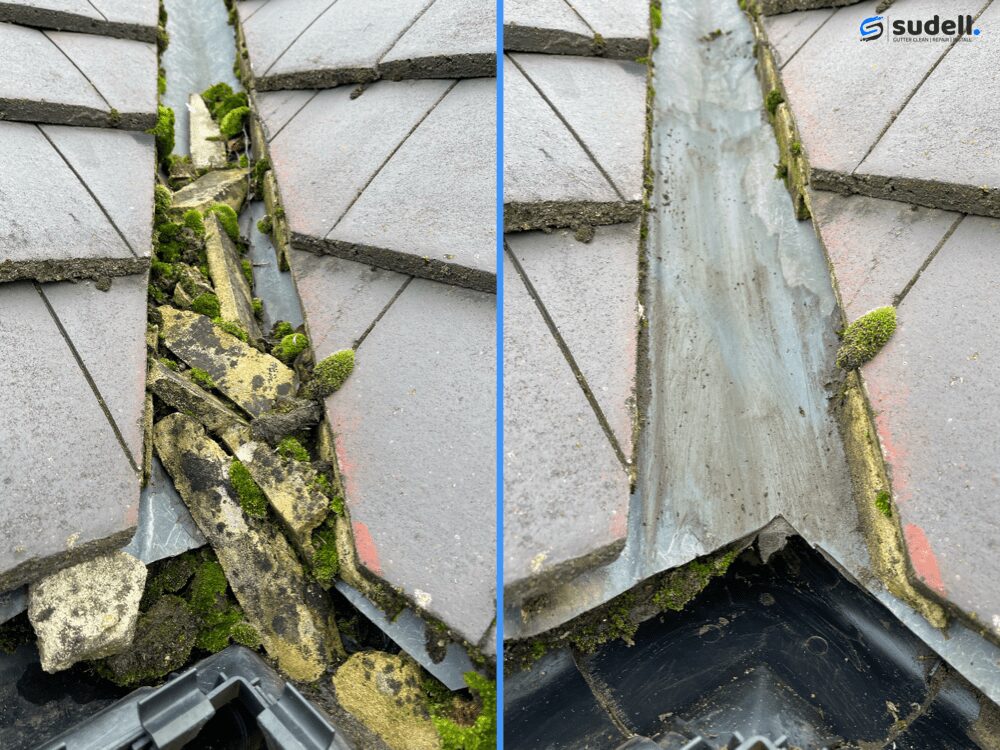
How do i clean out a valley gutter?
A commercial valley gutter can be cleaned out using a sweeping brush. Push all the debris to the opposite end to where the outlet is to prevent debris falling into the drains and causing blockages further down the drainage system. The debris can be scooped out into bags.
Tip. You can cut down a sweeping brush to the exact size of the valley gutter which will speed up the valley gutter cleaning process.
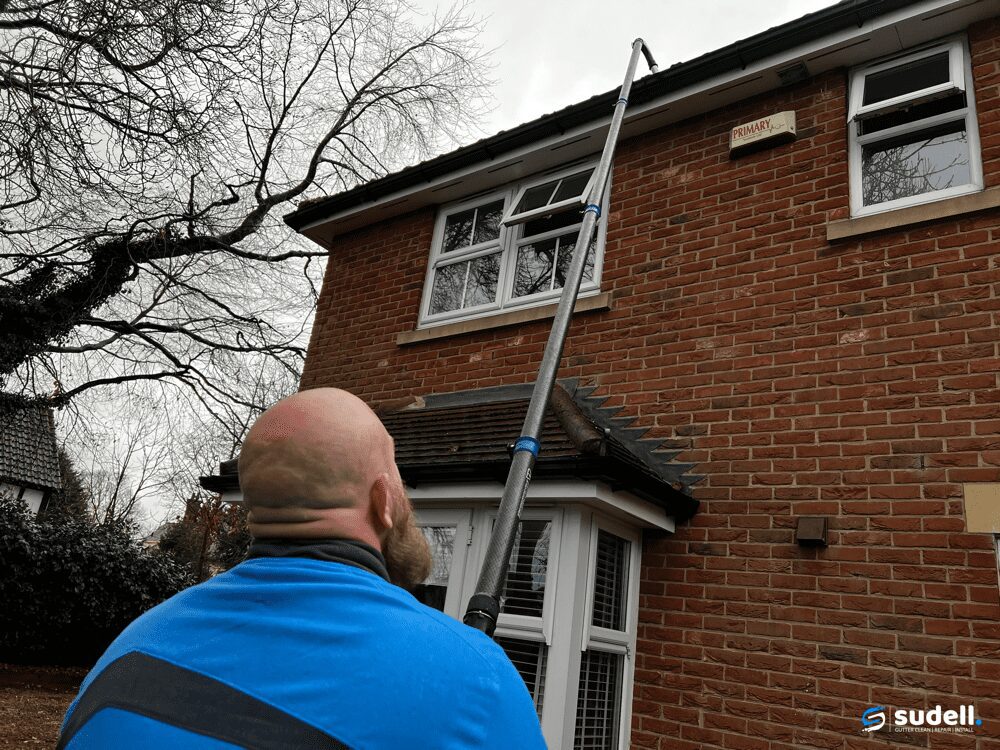
What is gutter vacuuming?
Gutter vacuuming is a process where gutters are cleaned out using a gutter vacuum system consisting of a high powered wet and dry gutter vacuum machine and extending poles.
Gutter vacuuming allows the user to clean out gutters safely from the ground without the need for ladders or other access equipment. Some gutter cleaning systems can reach gutters up to 40ft high, which is ideal for cleaning out gutters on two, three, and four storey buildings. Gutter vacuums can also help the user clean out gutters in difficult areas such as gutters over conservatories.
Gutter cleaning using a gutter vacuum is generally quicker and easier to complete and is mess-free. The debris removed from the gutter is collected in the gutter vacuum container making it easy to remove and dispose.
Related
It’s a misconception that birds nest in the gutter. In fact gutters would be one of the worst places that bird could choose to nest in. A birds nest in a gutter would be exposed to all weather conditions and would provide very little security for chicks.
If you have noticed an unusual amount of birds on your roof and what appear to be in and out of your gutter, the birds have probably found a opening in your roofline and are nesting under your roof tiles or in your loft space. Nests in the roof space are a perfect place for birds to nest as it provides warmth and protection for eggs and chicks.
Are gutter guards worth the money?
Gutter guards are not usually worth the money. In cases where gutters need to be cleaned out more than 4 times per year, gutter guards may help limit this to once or twice per year. Bare in mind, If gutter guards are installed, it will take longer to clean the gutters out.
In many circumstances it is a much better option to have the gutters cleaned out more frequently. Gutter guards are not maintenance free, so your gutters will still require routine attention.
Downpipe leaf protectors on the other hand are effective at preventing blockages in the downpipes and drains.
Related
Rainwater is free and can be used for many things including irrigation, flushing toilets and even to supply water for the the washing machine as long as appropriate filtration has taken place.
You can, but don’t expect miracles. Most DIY products are watered down and short-lived. Worse still, many of them contain harsh chemicals that can harm your roof, kill your plants, or stain your driveway if misapplied. Our biocide treatment is professional-grade, environmentally safe, and proven to last — no guesswork needed.
How do I unblock a floor gulley?
Floor gulleys, also known as floor drains and sometimes AKO drains, are designed to remove water and other liquids from a floor to prevent flooding and water damage. However, if these drains become clogged with debris, they can no longer function properly. This can lead to water buildup and potential flooding, which can cause damage to the building and create a breeding ground for harmful bacteria and pests. Cleaning out floor gulleys on a regular basis ensures that they are functioning properly and can help prevent costly repairs.
Cleaning out a floor gulley should be done carefully. Remove the metal/plastic grid covers, taking into consideration how they are secured. Some grid covers just pop off like the ones in the video, while others are secured with a screw. You should wear protective gloves before commencing work. The quickest, easiest and cleanest way to clean out a floor gulley is with a gutter cleaning vacuum. Alternatively, pull out the large debris by hand and sweep clean the floor gulley. Make sure you don’t sweep any debris down the outlet which could cause a blockage in the drain further down the pipe. Once clean ensure the grid covers are secured properly.
Landlord or Tenant: Who is responsible for gutter maintenance?
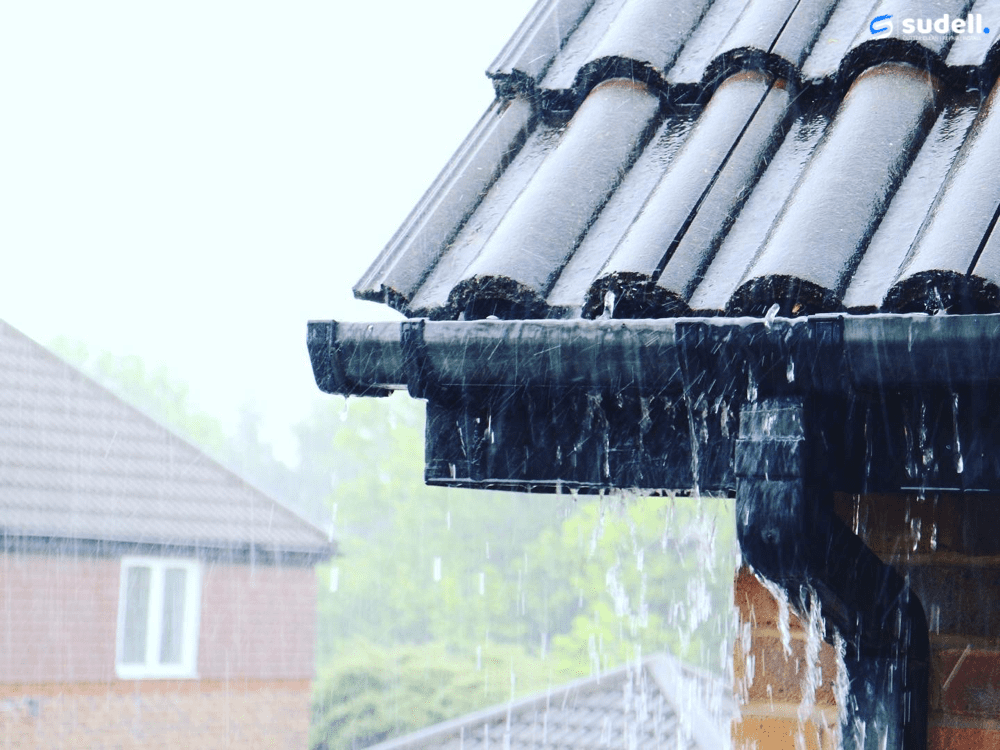
The tenancy agreement must establish clear-cut gutter maintenance responsibilities for rental properties.
It should comprehensively define who holds the responsibility for cleaning and repairing gutters throughout the tenancy.
In case the agreement puts the onus on landlords for gutter maintenance, they must ensure regular inspections and cleaning are carried out.
However, if the agreement assigns the responsibility to tenants, they must keep gutters debris-free.
Occasionally, both landlords and tenants may be responsible for maintaining gutters, with landlords scheduling annual professional cleaning and tenants reporting any gutter issues during their tenancy.
Further reading
Landlords vs Tenants: Who should clean and repair gutters in your rental property?
How much does it cost to repair a loose gutter?
Standard gutter repairs that require no fascia work can cost anywhere from £20 – £200. If the gutter is loose because of the fascia board, the price could exceed £400+
The cost to repair a loose gutter will depend on why the gutter is loose and will need to be investigated by a professional to find out why.
Common causes of loose gutters are:
- Rotten wooden fascia boards
- Snapped gutter/fascia brackets
- Gutter joints that have not been secured to the fascia board
- Incorrect fixings used to secure the gutter brackets
- Poor installation
- Insufficient amount of gutter brackets
Not the way we do it. We use tile-friendly tools and low-pressure methods, and we never walk on your roof. That means no cracked tiles, no leaks, and no shortcuts.
Not when applied professionally. We take precautions to protect surrounding greenery, patios, and wildlife. Our treatments are eco-friendly and applied with care — no careless spraying here.
Why does gutter cleaning cost so much?
A gutter cleaning service can seem expensive to some people however, the perception of cost and value differs from person to person.
Gutter cleaning is a high risk, manual job that needs to be managed to prevent injury and damage. This requires suitable training and experience to perform the job safely. This along with adequate insurance is therefore essential to protect you and the company.
Gutter cleaning is also a dirty job which can be difficult and time consuming to complete properly. Gutter cleaning may involve the use of access equipment and/or gutter cleaning vacuums and tools which can be very expensive to buy and maintain.
All of these elements may be considered by your gutter cleaning company and can reflect in the cost of their gutter cleaning service.
The most eco-friendly water butts have been made using recycled plastic which could otherwise have been sent to landfill. Water butts help us use less tap water which requires a lot of energy and chemicals to treat and purify.
NEWS STORIES…
Explore the latest updates on our activities with our general news coverage. [see all]
Gutter Cleaning Emergency: Local Hero Iain Saves the Day in Torrential Rain When storms hit, gutter emergencies can cause chaos and devastation. One such emergency [...]
Winter has arrived in all its snowy glory, and while the sight of snow-covered rooftops may have filled Instagram feeds with festive vibes, it’s [...]
So, here we are in October 2024, and Britain is getting absolutely pummeled by rain. It’s not just your typical drizzle anymore. Nope, it’s [...]
The Snow Has Officially Landed, and Your Roof is Having a Meltdown As the UK turns into a scene straight out of a festive snow [...]
As the UK gears up for a week of strong winds, expected to sweep across the country from January 20th to 27th, 2024, Sudell, a [...]
Sudell Gutter Services: Elevating Standards in Gutter Maintenance Through Advanced Working at Height Training Gutter Repair Training - Height Safety “Our gutter repair training stands [...]
Why choose us?
**Standard outlet and downpipe unblocking excludes any that require removal, alteration, or requires any part to be stripped or taken apart. An extra charge may be applied.






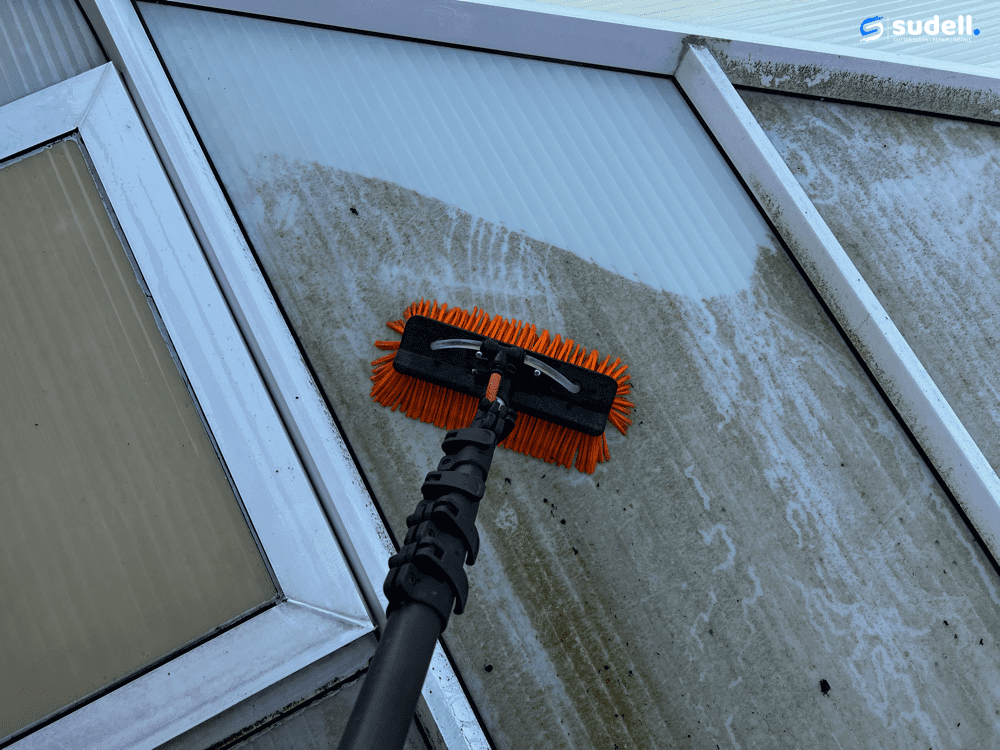


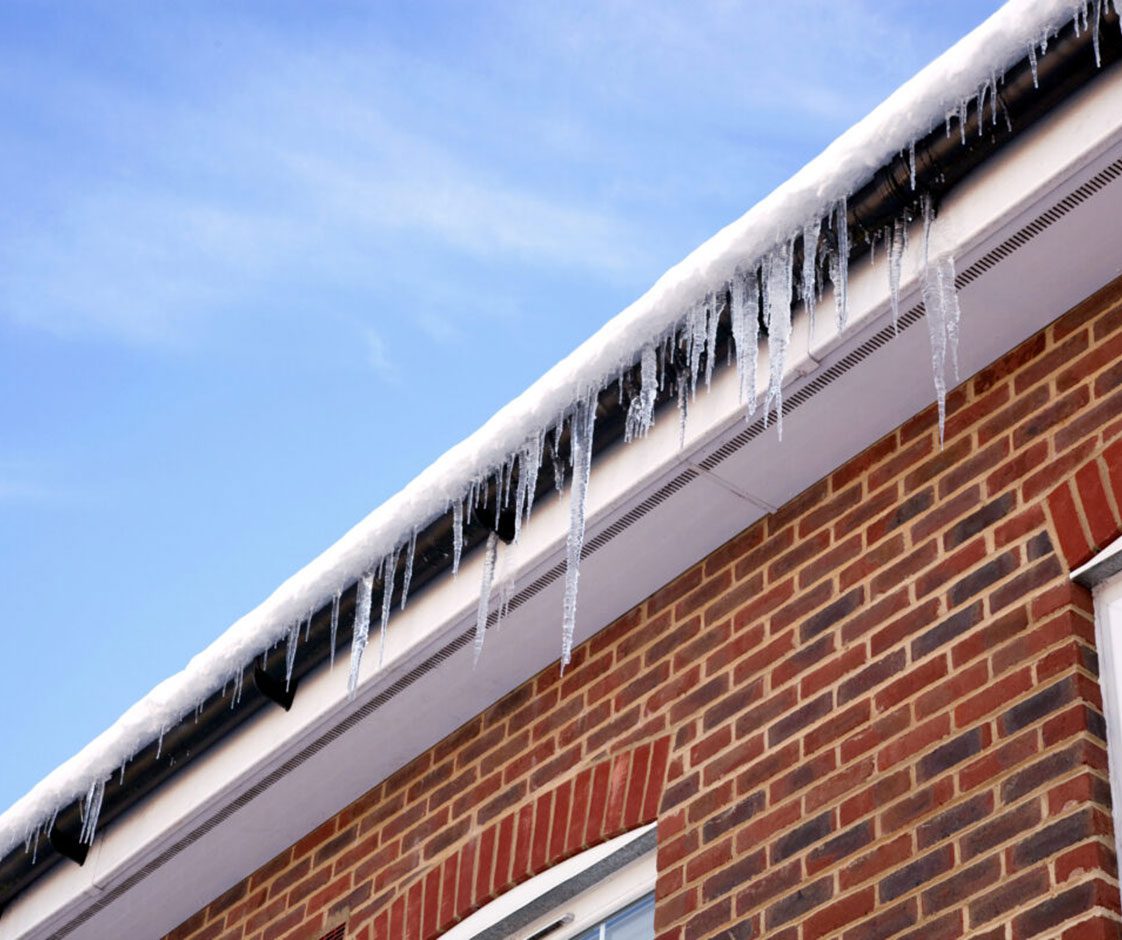


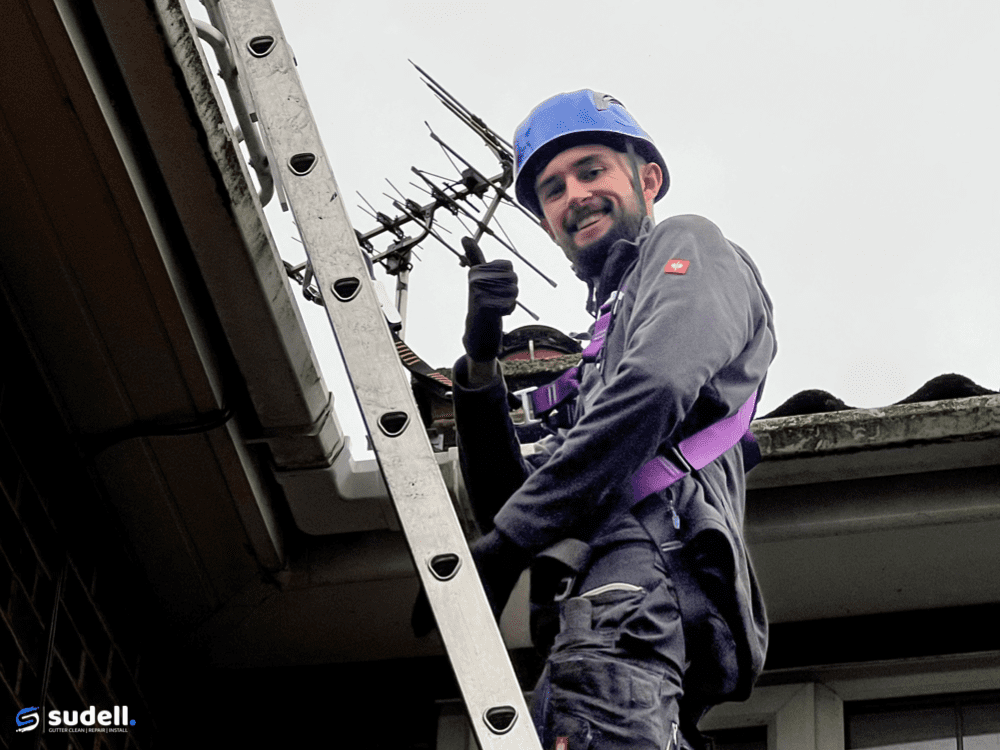
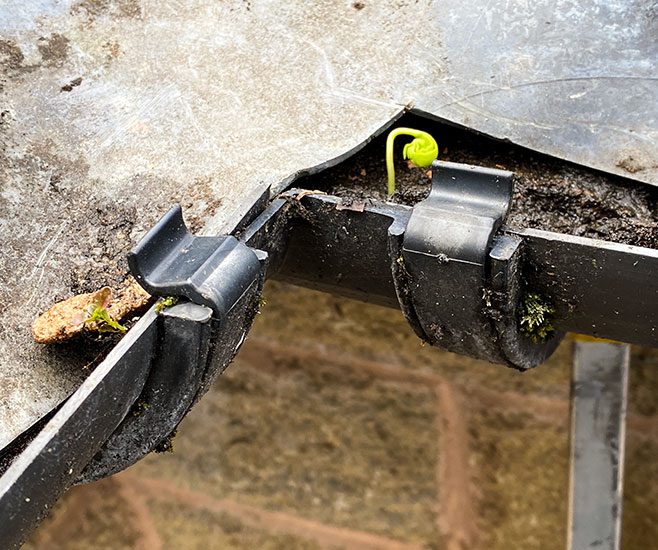
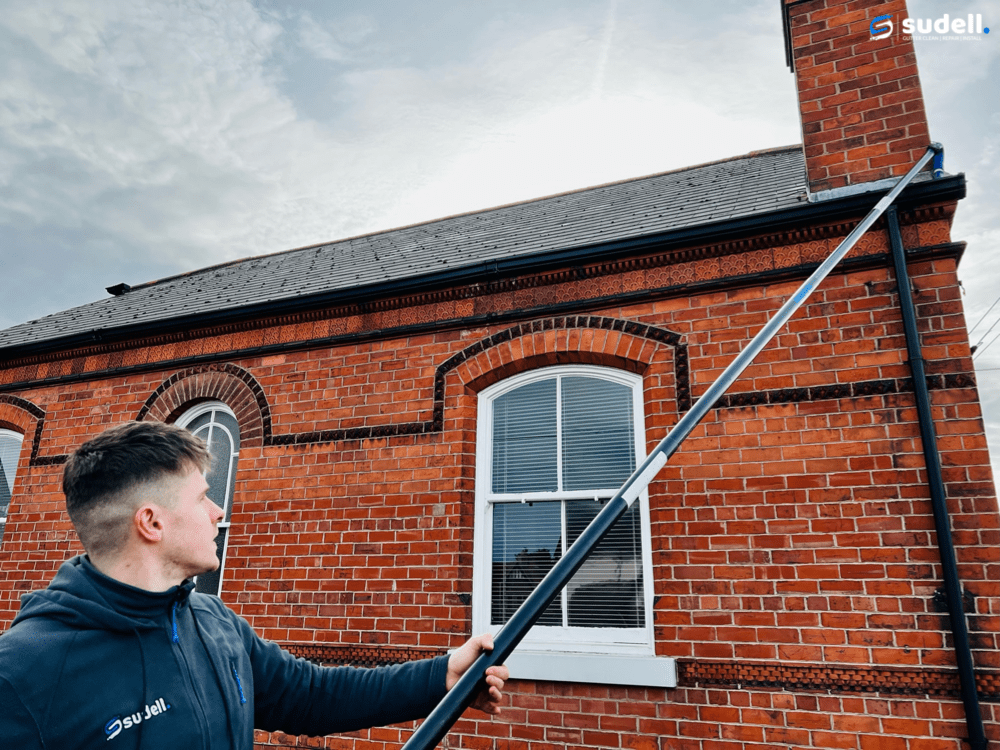


![New Home Gutter Care: Essential Tips for Homeowners [FREE CHECKLIST]](https://sudell.co.uk/wp-content/uploads/2024/01/4D3DF61F-B160-4BA2-A40A-00741B6AC2CD.png)


